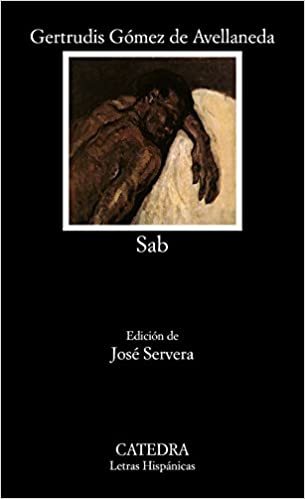Nava Atlas's Blog, page 48
December 11, 2020
To Flush, My Dog by Elizabeth Barrett Browning
Elizabeth Barrett Browning (1806 – 1861), the British poet, accomplished what few women writers did in her time — and that was gaining the respect and admiration of the literary world. In fact, she was far better known than her husband, fellow poet Robert Browning, in their lifetime.
Mary Russell Mitford, another writer, gave Elizabeth the cocker spaniel she named Flush as solace after the death of her brother in 1840.
From the start, Elizabeth adored Flush, so much so that she dedicated this poem to him. However, Flush wasn’t always on board with Robert Browning, his rival for Elizabeth’s affection, as detailed in this article. Browning even endured a few mean bites during their legendary courtship.
Though Flush wasn’t in attendance at the Brownings’ secret wedding, he was part of their escape to Florence, Italy, where they settled in 1847. It was fortunate that he was safely at home at this juncture, as poor Flush had been stolen three times.
. . . . . . . . . .
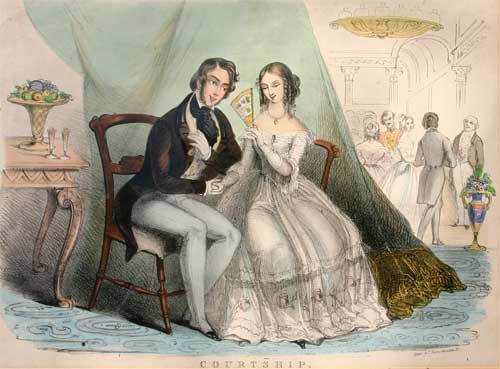
The Literary Love Story of Elizabeth Barrett and Robert Browning
. . . . . . . . . .
Flush may not have become as famous as his mistress, but no subsequent depiction of her life story would have been complete without him. He featured in the 1934 film, The Barretts of Wimpole Street, and in Flush, a “biography” of him written by Virginia Woolf (and illustrated by her sister, Vanessa Bell), published in 1933.
It’s unclear when exactly the poem “To Flush, My Dog” was written, but it seems safe to surmise that it was sometime between when Elizabeth received him in 1840 and 1847 when she departed with him and Robert to Italy.
More on Elizabeth and Flush
Then and There Flush with Love
“Too Caninely Noble” — On Elizabeth’s life with Flush and Virginia Woolf’s biography
Analysis of “To Flush, My Dog”
More poetry by Elizabeth Barrett Browning on this site
“A Dead Rose”: An Ecocritical Reading
“To George Sand: A Desire”
. . . . . . . . . .

Norma Shearer as Elizabeth Barrett Browning
in the 1934 film, The Barretts of Wimpole Street
. . . . . . . . . .
To Flush, My Dog
LOVING friend, the gift of one,
Who, her own true faith, hath run,
Through thy lower nature;
Be my benediction said
With my hand upon thy head,
Gentle fellow-creature!
Like a lady’s ringlets brown,
Flow thy silken ears adown
Either side demurely,
Of thy silver-suited breast
Shining out from all the rest
Of thy body purely.
Darkly brown thy body is,
Till the sunshine, striking this,
Alchemize its dulness, —
When the sleek curls manifold
Flash all over into gold,
With a burnished fulness.
Underneath my stroking hand,
Startled eyes of hazel bland
Kindling, growing larger, —
Up thou leapest with a spring,
Full of prank and curvetting,
Leaping like a charger.
Leap! thy broad tail waves a light;
Leap! thy slender feet are bright,
Canopied in fringes.
Leap — those tasselled ears of thine
Flicker strangely, fair and fine,
Down their golden inches.
Yet, my pretty sportive friend,
Little is ‘t to such an end
That I praise thy rareness!
Other dogs may be thy peers
Haply in these drooping ears,
And this glossy fairness.
But of thee it shall be said,
This dog watched beside a bed
Day and night unweary, —
Watched within a curtained room,
Where no sunbeam brake the gloom
Round the sick and dreary.
Roses, gathered for a vase,
In that chamber died apace,
Beam and breeze resigning —
This dog only, waited on,
Knowing that when light is gone,
Love remains for shining.
Other dogs in thymy dew
Tracked the hares and followed through
Sunny moor or meadow —
This dog only, crept and crept
Next a languid cheek that slept,
Sharing in the shadow.
Other dogs of loyal cheer
Bounded at the whistle clear,
Up the woodside hieing —
This dog only, watched in reach
Of a faintly uttered speech,
Or a louder sighing.
And if one or two quick tears
Dropped upon his glossy ears,
Or a sigh came double, —
Up he sprang in eager haste,
Fawning, fondling, breathing fast,
In a tender trouble.
And this dog was satisfied,
If a pale thin hand would glide,
Down his dewlaps sloping, —
Which he pushed his nose within,
After, — platforming his chin
On the palm left open.
This dog, if a friendly voice
Call him now to blyther choice
Than such chamber-keeping,
Come out! praying from the door, —
Presseth backward as before,
Up against me leaping.
Therefore to this dog will I,
Tenderly not scornfully,
Render praise and favour!
With my hand upon his head,
Is my benediction said
Therefore, and for ever.
And because he loves me so,
Better than his kind will do
Often, man or woman,
Give I back more love again
Than dogs often take of men, —
Leaning from my Human.
Blessings on thee, dog of mine,
Pretty collars make thee fine,
Sugared milk make fat thee!
Pleasures wag on in thy tail —
Hands of gentle motion fail
Nevermore, to pat thee!
Downy pillow take thy head,
Silken coverlid bestead,
Sunshine help thy sleeping!
No fly ‘s buzzing wake thee up —
No man break thy purple cup,
Set for drinking deep in.
Whiskered cats anointed flee —
Sturdy stoppers keep from thee
Cologne distillations;
Nuts lie in thy path for stones,
And thy feast-day macaroons
Turn to daily rations!
Mock I thee, in wishing weal? —
Tears are in my eyes to feel
Thou art made so straightly,
Blessing needs must straighten too, —
Little canst thou joy or do,
Thou who lovest greatly.
Yet be blessed to the height
Of all good and all delight
Pervious to thy nature, —
Only loved beyond that line,
With a love that answers thine,
Loving fellow-creature!
. . . . . . . . . . . .
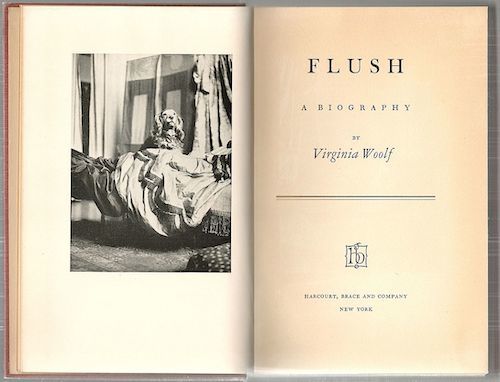
More about Virginia Woolf’s biography of Elizabeth Barrett Browning’s spaniel, Flush
The post To Flush, My Dog by Elizabeth Barrett Browning appeared first on Literary Ladies Guide.
December 9, 2020
Margaret Fuller, Trailblazing Journalist and Reformer
Margaret Fuller (born Sarah Margaret Fuller; later Margaret Fuller Ossoli; 1810 – 1850) was a well-known figure in her lifetime as a women’s rights advocate, abolitionist, editor, and journalist. For a time, she was considered the best-read person in New England and became the first woman to gain access to Harvard’s library.
In 1844, Margaret joined the New York Herald Tribune as America’s first full-time book reviewer. In 1846, she became the Tribune’s first woman editor and first female foreign correspondent. After spending four tumultuous and productive years in Europe, Fuller died tragically in a ship accident upon returning to America, leaving a legacy that was controversial as it was unique.
A staunch advocate of women’s rights (especially in the areas of education and employment), she was also active in the areas of prison reform and was an abolitionist before the Civil War. Many reformers who came after her, including Susan B. Anthony, cited Margaret Fuller as an inspiration.
Because her life was cut short, she didn’t have time to publish many full-length works (and devoted much of her career to being an editor, journalist, and teacher), but her 1845 book, Woman in the Nineteenth Century, was her magnum opus. Though her renown and reputation faded shortly after her death, her life and work are certainly deserving of reconsideration.
The following biography of Margaret Fuller has been adapted from Lives of Girls Who Became Famous by Sarah Knowles Bolton, 1886/1914, hence the somewhat florid language.
A precocious child
Margaret Fuller, in some respects the most remarkable of American women, lived a pathetic life and died a tragic death. Without money or beauty, she became the idol of an immense circle of friends; men and women were alike her devotees. It is the old story: that the woman with brains makes lasting conquests of hearts, while the pretty face holds its sway only for a month or a year.
Margaret, born in Cambridgeport, Massachusetts on May 23, 1810, was the oldest child of a scholarly lawyer, Mr. Timothy Fuller, and of a sweet-tempered, devoted mother. The father, with small means, had one absorbing purpose in life—to see that each of his children was finely educated. To do this, and make ends meet, was a struggle.
Very fond of his oldest child, Margaret, the father determined that she should be as well educated as his boys. In those days there were no colleges for girls and none where they might enter with their brothers, so Mr. Fuller was obliged to teach his daughter after the wearing work of the day.
The bright child began to read Latin at age six, but was necessarily kept up late for the recitation. When a little later she was walking in her sleep, and dreaming strange dreams, he did not see that he was overtaxing both her body and brain.
When not reading, Margaret enjoyed her mother’s little garden of flowers: “I loved to gaze on the roses, the violets, the lilies, the pinks; my mother’s hand had planted them, and they bloomed for me. I kissed them, and pressed them to my bosom with passionate emotions. An ambition swelled my heart to be as beautiful, as perfect as they.”
. . . . . . . . . .
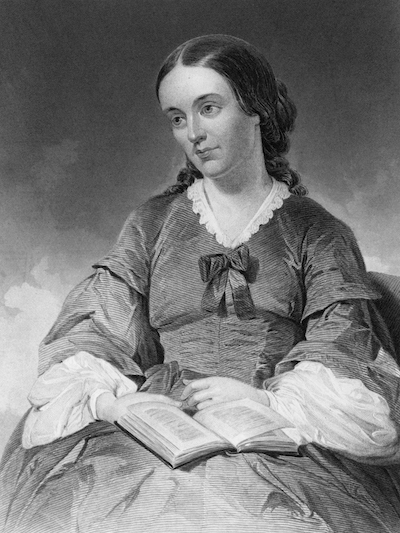
. . . . . . . . . .
A studious teen
Margaret grew to fifteen with an exuberance of life and affection, which the chilling atmosphere of that New England home somewhat suppressed, and with an increasing love for books and cultured people.
“I rise a little before five,” she wrote, “walk an hour, and then practice on the piano till seven, when we breakfast. Next, I read French — Sismondi’s Literature of the South of Europe — till eight; then two or three lectures in Brown’s Philosophy. About half-past nine I go to Mr. Perkins’s school, and study Greek till twelve, when, the school being dismissed, I recite, go home, and practice again till dinner, at two. Then, when I can, I read two hours in Italian.”
And why all this hard work for a girl of fifteen? The “all-powerful motive of ambition,” she claimed. “I am determined on distinction, which formerly I thought to win at an easy rate; but now I see that long years of labor must be given.”
Two years after, at seventeen, she wrote: “I am studying Madame de Staël, Epictetus, Milton, Racine, and the Castilian ballads, with great delight … I am engrossed in reading the elder Italian poets, beginning with Berni, from whom I shall proceed to Pulci and Politian.”
A well-loved figure
Witty, learned, imaginative, she was conceded to be the best conversationist in any circle. She possessed the charm that every woman may possess — appreciation of others, and interest in their welfare.
This sympathy unlocked every heart to her. All loved her. Now it was a serving girl who told Margaret her troubles and her cares; now it was a distinguished man of letters. She was always an inspiration. Men never talked idle, commonplace talk with her; she could appreciate the best of their minds and hearts, and they gave it. She was fond of social life, and no party seemed complete without her.
Starting to teach and a breakdown in health
At age twenty-two, she began to study German, and in three months was reading with ease Goethe’s Faust, Tasso and Iphigenia, Körner, Richter, and Schiller. She greatly admired Goethe, desiring, like him, “always to have some engrossing object of pursuit.” Besides all this study she was teaching six little children, to help bear the expenses of the household.
The family at this time moved to Groton, a great privation for Margaret, who enjoyed and needed the culture of Boston society. The teaching was continued because her brothers must be sent to Harvard College, and this required money; not the first nor the last time that sisters have worked to give their brothers an education superior to their own.
At last, the constitution, never robust, broke down, and for nine days Margaret lay hovering between this world and the next.
While Margaret recovered, her father was taken suddenly with cholera and died after two days’ illness. He was sadly missed, for at heart he was devoted to his family. When the estate was settled, there was little left for each; so for Margaret life would be more laborious than ever.
She had expected to visit Europe with Harriet Martineau, who was just returning home from a visit to this country, but the father’s death crushed this long-cherished and ardently-prayed-for journey. She must stay at home and work for others.
Margaret now obtained a situation as a teacher of French and Latin in Bronson Alcott‘s school. Here she was appreciated by both master and pupils. Mr. Alcott said, “I think her the most brilliant talker of the day. She has a quick and comprehensive wit, a firm command of her thoughts, and a speech to win the ear of the most cultivated.” She taught advanced classes in German and Italian, besides having several private pupils.
She was passionately fond of music and art, saying, “I have been very happy with four hundred and seventy designs of Raphael in my possession for a week.” She loved nature like a friend, paying homage to rocks and woods and flowers. She said, “I hate not to be beautiful when all around is so.”
Beginning as a speaker and editor
After teaching with Mr. Alcott, she became the principal teacher in a school at Providence, R.I. Here, as ever, she showed great wisdom both with children and adults. After two years in Providence she returned to Boston, and in 1839 began a series of parlor lectures, or “conversations,” as they were called.
This seemed a strange thing for a woman, when public speaking by her sex was almost unknown. These talks were given weekly, from eleven o’clock till one, to twenty-five or thirty of the most cultivated women of the city.
Now the subject of discussion was Grecian mythology; now it was fine arts, education, or the relations of a woman to the family, the church, society, and literature. In these gatherings, Margaret was at her best — brilliant, eloquent, charming.
During this time a few gifted men, Emerson, Channing, and others, decided to start a literary and philosophical magazine called the Dial. Probably no woman in the country would have been chosen as the editor, save Margaret Fuller. She accepted the position, and for four years managed the journal ably, writing for it some valuable essays.
Some of these were published later in her book on Literature and Art. Her Woman in the Nineteenth Century, a learned and vigorous essay on woman’s place in the world, first appeared in part in the Dial.
Of this work, she said, in closing it, “After taking a long walk, early one most exhilarating morning, I sat down to work, and did not give it the last stroke till near nine in the evening. Then I felt a delightful glow, as if I had put a good deal of my true life in it, and as if, should I go away now, the measure of my footprint would be left on the earth.”
A writer and translator
Margaret Fuller had published, besides these works, two books of translations from German, and a sketch of travel called Summer on the Lakes. Her experience was like that of most authors who are beginning—some fame, but no money realized. All this time she was frail in health, overworked, struggling against odds to make a living for herself and those she loved.
Margaret was now thirty-four. Her sister was married, the brothers had finished their college course, and she was about to accept an offer from the New York Tribune to become one of its constant contributors, an honor that few women would have received. Early in December 1844, Margaret moved to New York and became a member of Horace Greeley‘s newspaper family. Her literary work here was that of “the best literary critic whom America has yet seen.”
A European journey
A year and a half later an opportunity came for Margaret to go to Europe. Now, at last, she would see the art galleries of the old world, and places rich in history, like Rome. Still, there was the trouble of scanty means and poor health from overwork.
She said, “A noble career is yet before me if I can be unimpeded by cares. If our family affairs could now be so arranged that I might be tolerably tranquil for the next six or eight years, I should go out of life better satisfied with the page I have turned in it than I shall if I must still toil on.”
In Paris, Margaret attended the Academy lectures, saw much of George Sand, waded through melting snow at Avignon to see Laura’s tomb, and at last was in Italy, the country she had longed to see.
Here she settled down to systematic work, trying to keep her expenses for six months within four hundred dollars. Still, when most cramped for means herself, she was always generous. Once, when living on a mere pittance, she loaned fifty dollars to a needy artist.
In New York she gave an impecunious author five hundred dollars to publish his book, and, of course, never received a dollar in return. Yet the race for life was wearing her out. So tired was she that she said, “I should like to go to sleep, and be born again into a state where my young life should not be prematurely taxed.”
. . . . . . . . .
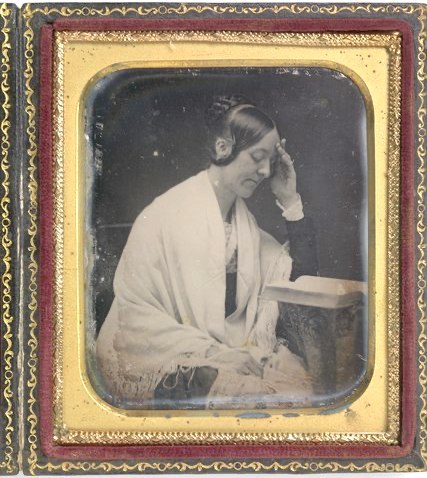
. . . . . . . . .
Falling in love in Italy
Margaret befriended Italian revolutionary Giuseppe Mazzini, and was enthusiastic for Roman liberty. All those dreadful months she ministered to the wounded and dying in the hospitals, and was their “saint,” as they called her. But there was another reason why Margaret Fuller loved Italy.
Soon after her arrival in Rome, as she was attending vespers at St. Peter’s with a party of friends, she became separated from them. Failing to find them, seeing her anxious face, a young Italian came up to her, and politely offered to assist her.
Unable to regain her friends, Angelo Ossoli walked with her to her home, though he could speak no English, and she almost no Italian. She learned afterward that he was of a noble and refined family; that his brothers were in the Papal army, and that he was highly respected.
After this, he saw Margaret once or twice when she left Rome for some months. On her return, he renewed the acquaintance, shy and quiet though he was, for her influence seemed great. His father, the Marquis Ossoli, had just died, and Margaret, with her large heart, sympathized with him.
Finally, he confessed to Margaret that he loved her and that he “must marry her or be miserable.” She refused to listen to him as a lover, said he must marry a younger woman—she was thirty-seven, and he but thirty—but she would be his friend. For weeks he was dejected and unhappy.
She debated the matter with her own heart. Should she, who had had many admirers, now marry a man her junior, and not of surpassing intellect, like her own? If she married him, it must be kept a secret till his father’s estate was settled, for marriage with a Protestant would spoil all prospect of an equitable division.
Love conquered, and she married the young Marquis Ossoli in December 1847. He gave Margaret the kind of love which lasts after marriage, veneration of her ability and her goodness.
“Such tender, unselfish love,” recalled a friend of Margaret’s. “I have rarely before seen; it made green her days, and gave her an expression of peace and serenity which before was a stranger to her. When she was ill, he nursed and watched over her with the tenderness of a woman. No service was too trivial, no sacrifice too great for him. ‘How sweet it is to do little things for you,’ he would say.”
To her mother, Margaret wrote, though she did not tell her secret, “I have not been so happy since I was a child, as during the last six weeks.”
The horrors of war
But days of anxiety soon came, with all the horrors of war. Ossoli was constantly exposed to death in that dreadful siege of Rome. Then Rome fell, and with it the hopes of Ossoli and his wife. There would be neither fortune nor home for a Liberal now — only exile. Very sadly Margaret said goodbye to the soldiers in the hospitals, brave fellows whom she honored, who in the midst of death itself, would cry “Viva l’Italia!”
But before leaving Rome, a day’s journey must be made to Rieta, at the foot of the Umbrian Apennines. And for what? The most precious thing of Margaret’s life was there — her baby. The fair child, with blue eyes and light hair like her own, had already been named by the people in the house, Angelino, from his beauty.
. . . . . . . . . .
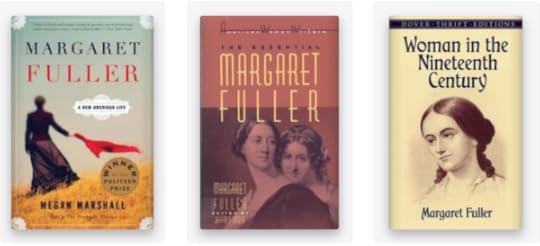
Books by and about Margaret Fuller on Bookshop.org*
Books by and about Margaret Fuller on Amazon*
. . . . . . . . . .
Becoming a mother
Margaret had always been fond of children, and now a new joy had come into her heart, a child of her own.
She wrote to her mother: “In him, I find satisfaction, for the first time, to the deep wants of my heart. Nothing but a child can take the worst bitterness out of life, and break the spell of loneliness. I shall not be alone in other worlds, whenever Eternity may call me … I wake in the night — I look at him. He is so beautiful and good, I could die for him!”
When Ossoli and Margaret reached Rieta, what was their horror to find their child worn to a skeleton, half-starved through the falsity of a nurse. For four weeks the distressed parents coaxed him back to life, till the sweet beauty of the rounded face came again, and then they carried him to Florence, where, despite poverty and exile, they were happy.
Considering a return to America
Margaret’s friends now urged her to return to America. She had nearly finished a history of Rome in this trying time, 1848, and could better attend to its publication in this country. Ossoli, though coming to a land of strangers, could find something to help, support the family.
To save expense, they started from Leghorn, May 17, 1850, in the Elizabeth, a sailing vessel, though Margaret dreaded the two months’ voyage, and had premonitions of disaster. She wrote:
“I have a vague expectation of some crisis — I know not what. But it has long seemed that, in the year 1850, I should stand on a plateau in the ascent of life, when I should be allowed to pause for a while, and take more clear and commanding views than ever before. Yet my life proceeds as regularly as the fates of a Greek tragedy, and I can but accept the pages as they turn …
I shall embark, praying fervently that it may not be my lot to lose my boy at sea, either by unsolaced illness, or amid the howling waves; or, if so, that Ossoli, Angelo, and I may go together, and that the anguish may be brief.”
For a few days, all went well on shipboard. Then the noble Captain Hasty died of small-pox, and was buried at sea. Angelino took this dread disease, and for a time his life was despaired of, but he finally recovered and became a great pet with the sailors. Margaret was putting the last touches to her book. Ossoli and young Sumner, brother of Charles, gave each other lessons in Italian and English, and thus the weeks went by.
A tragedy in the making
On Thursday, July 18, after two months, the Elizabeth stood off the Jersey coast, between Cape May and Barnegat. Trunks were packed, good nights were spoken, and all were happy, for they would be in New York on the morrow.
At nine that night a gale arose; at midnight it was a hurricane; at four o’clock, Friday morning, the ship struck Fire Island beach. The passengers sprung from their berths. “We must die!” said Sumner to Mrs. Hasty. “Let us die calmly, then!” was the response of the widow of the captain.
One of the sailors suggested that if each passenger would sit on a plank, holding on by ropes, they would attempt to push him or her to land. Margaret was urged, but she hesitated, unless all three could be saved. Every moment the danger increased.
Margaret had finally been induced to try the plank. The steward had taken Angelino in his arms, promising to save him or die with him, when a strong sea swept the forecastle, and all went down together.
Ossoli caught the rigging for a moment, but Margaret sank at once. When last seen, she was seated at the foot of the foremast, still clad in her white nightdress, with her hair fallen loose upon her shoulders. Angelino and the steward were washed up on the beach twenty minutes later, both dead, though warm. Margaret’s prayer was answered—that they “might go together, and that the anguish might be brief.”
The pretty boy of two years was dressed in a child’s frock taken from his mother’s trunk, which had come to shore, laid in a seaman’s chest, and buried in the sand, while the sailors, who loved him, stood around, weeping. His body was finally removed to Mt. Auburn, and buried in the family lot.
Bodies never recovered
The bodies of Margaret and Ossoli were never recovered. The only papers of value that came to shore were their love letters, now deeply prized. The book ready for publication was never found.
When those on shore were asked why they did not launch the life-boat, they replied, “Oh! if we had known there were any such persons of importance on board, we should have tried to do our best!”
Thus, at forty, died one of the most gifted women in America, when her work seemed just begun. To us, who see how the world needed her, her death is a mystery. She filled her life with charities and her mind with knowledge, and such are ready for the progress of Eternity.
More about Margaret Fuller
Major Works
Summer on the Lakes (1844)
Woman in the Nineteenth Century (1845)
Papers on Literature and Art (1846)
Memoirs of Margaret Fuller Ossoli (1852)
At Home and Abroad (1856)
Life Without and Life Within (1858)
Biographies
Margaret Fuller (Marchesa Ossoli) by Julia Ward Howe (1883)
The Essential Margaret Fuller by Jeffrey Steele, 1992
Margaret Fuller: An American Romantic Life by Charles Capper, 2010
The Lives of Margaret Fuller by John Matteson, 2012
Margaret Fuller: A New American Life by Megan Marshall, 2014
More about Margaret Fuller
Wikipedia
“An unfinished woman: The desires of Margaret Fuller” by Judith Thurman
Margaret Fuller and Her Conversations
. . . . . . . . . .
*These are Bookshop Affiliate and Amazon Affiliate links. If a product is purchased by linking through, Literary Ladies Guide receives a modest commission, which helps maintain our site and helps it to continue growing!
The post Margaret Fuller, Trailblazing Journalist and Reformer appeared first on Literary Ladies Guide.
December 4, 2020
Sonnets from the Portuguese by Elizabeth Barrett Browning (full text)
Elizabeth Barrett Browning (1806 – 1861) was immensely accomplished and respected in her own lifetime, no small accomplishment for a female poet. Following is the full text of what is arguably her best-known work, Sonnets from the Portuguese, a fragment of one of her major collections, Poems (1844/1850).
Born in County Durham, England, Elizabeth Barrett grew up in an atmosphere of privilege and culture, which allowed her to develop a precocious talent in poetry.
After having a collections of her poetry published while still in her teens, Elizabeth was introduced to British literary society in the 1830s. Her individual poems were becoming known and respected in these circles.
. . . . . . . . . .
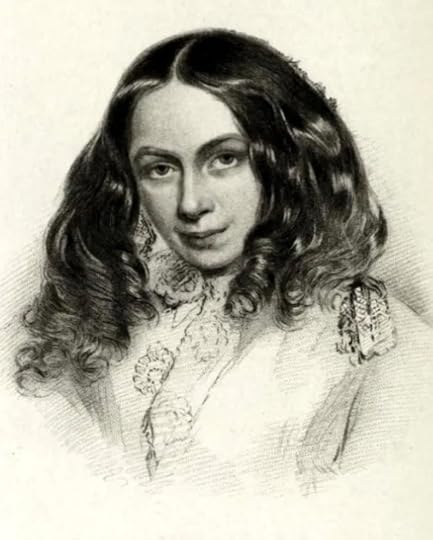
More about Elizabeth Barrett Browning
. . . . . . . . . .
Her first collection, Poems (1844) was an immediate success in Europe and the U.S. and made her famous. A Drama of Exile: and Other Poems (1845) cemented her reputation.
In 1850, her collection, Poems, was published in a new and expanded edition. It contained what is now considered one of her masterpieces, Sonnets from the Portuguese, the collection of forty-four love poems she wrote in secret to her husband, Robert Browning, presented here.
The title alludes to one of his pet names for her, when he called her ‘my Portuguese.’ The couple had one of the most romantic of love stories between two major literary figures. Sonnets from the Portuguese is in the public domain.
. . . . . . . . . .

The Literary Love Story of Elizabeth Barrett and Robert Browning
. . . . . . . . . .
According to her biography on Poetry Foundation:
“Among all female poets of the English-speaking world in the 19th century, none was held in higher critical esteem or was more admired for the independence and courage of her views than Elizabeth Barrett Browning.
During the years of her marriage to Robert Browning, her literary reputation far surpassed that of her poet-husband; when visitors came to their home in Florence, she was invariably the greater attraction. She had a wide following among cultured readers in England and in the United States.”
More about Sonnets from the Portuguese
Encyclopedia
Jstor: The Female Poet and the Embarrassed Reader
Analysis of Sonnet 43, “How do I love thee?”
. . . . . . . . . . . .
Sonnets from the Portuguese by Elizabeth Barrett Browning
I
I thought once how Theocritus had sung
Of the sweet years, the dear and wished-for years,
Who each one in a gracious hand appears
To bear a gift for mortals, old or young:
And, as I mused it in his antique tongue,
I saw, in gradual vision through my tears,
The sweet, sad years, the melancholy years,
Those of my own life, who by turns had flung
A shadow across me. Straightway I was ’ware,
So weeping, how a mystic Shape did move
Behind me, and drew me backward by the hair;
And a voice said in mastery, while I strove,—
“Guess now who holds thee!”—“Death,” I said, But, there,
The silver answer rang, “Not Death, but Love.”
II
But only three in all God’s universe
Have heard this word thou hast said,—Himself, beside
Thee speaking, and me listening! and replied
One of us . . . that was God, . . . and laid the curse
So darkly on my eyelids, as to amerce
My sight from seeing thee,—that if I had died,
The death-weights, placed there, would have signified
Less absolute exclusion. “Nay” is worse
From God than from all others, O my friend!
Men could not part us with their worldly jars,
Nor the seas change us, nor the tempests bend;
Our hands would touch for all the mountain-bars:
And, heaven being rolled between us at the end,
We should but vow the faster for the stars.
III
Unlike are we, unlike, O princely Heart!
Unlike our uses and our destinies.
Our ministering two angels look surprise
On one another, as they strike athwart
Their wings in passing. Thou, bethink thee, art
A guest for queens to social pageantries,
With gages from a hundred brighter eyes
Than tears even can make mine, to play thy part
Of chief musician. What hast thou to do
With looking from the lattice-lights at me,
A poor, tired, wandering singer, singing through
The dark, and leaning up a cypress tree?
The chrism is on thine head,—on mine, the dew,—
And Death must dig the level where these agree.
IV
Thou hast thy calling to some palace-floor,
Most gracious singer of high poems! where
The dancers will break footing, from the care
Of watching up thy pregnant lips for more.
And dost thou lift this house’s latch too poor
For hand of thine? and canst thou think and bear
To let thy music drop here unaware
In folds of golden fulness at my door?
Look up and see the casement broken in,
The bats and owlets builders in the roof!
My cricket chirps against thy mandolin.
Hush, call no echo up in further proof
Of desolation! there’s a voice within
That weeps . . . as thou must sing . . . alone, aloof.
V
I lift my heavy heart up solemnly,
As once Electra her sepulchral urn,
And, looking in thine eyes, I over-turn
The ashes at thy feet. Behold and see
What a great heap of grief lay hid in me,
And how the red wild sparkles dimly burn
Through the ashen greyness. If thy foot in scorn
Could tread them out to darkness utterly,
It might be well perhaps. But if instead
Thou wait beside me for the wind to blow
The grey dust up, . . . those laurels on thine head,
O my Belovëd, will not shield thee so,
That none of all the fires shall scorch and shred
The hair beneath. Stand further off then! go!
VI
Go from me. Yet I feel that I shall stand
Henceforward in thy shadow. Nevermore
Alone upon the threshold of my door
Of individual life, I shall command
The uses of my soul, nor lift my hand
Serenely in the sunshine as before,
Without the sense of that which I forbore—
Thy touch upon the palm. The widest land
Doom takes to part us, leaves thy heart in mine
With pulses that beat double. What I do
And what I dream include thee, as the wine
Must taste of its own grapes. And when I sue
God for myself, He hears that name of thine,
And sees within my eyes the tears of two.
VII
The face of all the world is changed, I think,
Since first I heard the footsteps of thy soul
Move still, oh, still, beside me, as they stole
Betwixt me and the dreadful outer brink
Of obvious death, where I, who thought to sink,
Was caught up into love, and taught the whole
Of life in a new rhythm. The cup of dole
God gave for baptism, I am fain to drink,
And praise its sweetness, Sweet, with thee anear.
The names of country, heaven, are changed away
For where thou art or shalt be, there or here;
And this . . . this lute and song . . . loved yesterday,
(The singing angels know) are only dear
Because thy name moves right in what they say.
VIII
What can I give thee back, O liberal
And princely giver, who hast brought the gold
And purple of thine heart, unstained, untold,
And laid them on the outside of the wall
For such as I to take or leave withal,
In unexpected largesse? am I cold,
Ungrateful, that for these most manifold
High gifts, I render nothing back at all?
Not so; not cold,—but very poor instead.
Ask God who knows. For frequent tears have run
The colours from my life, and left so dead
And pale a stuff, it were not fitly done
To give the same as pillow to thy head.
Go farther! let it serve to trample on.
IX
Can it be right to give what I can give?
To let thee sit beneath the fall of tears
As salt as mine, and hear the sighing years
Re-sighing on my lips renunciative
Through those infrequent smiles which fail to live
For all thy adjurations? O my fears,
That this can scarce be right! We are not peers
So to be lovers; and I own, and grieve,
That givers of such gifts as mine are, must
Be counted with the ungenerous. Out, alas!
I will not soil thy purple with my dust,
Nor breathe my poison on thy Venice-glass,
Nor give thee any love—which were unjust.
Beloved, I only love thee! let it pass.
X
Yet, love, mere love, is beautiful indeed
And worthy of acceptation. Fire is bright,
Let temple burn, or flax; an equal light
Leaps in the flame from cedar-plank or weed:
And love is fire. And when I say at need
I love thee . . . mark! . . . I love thee—in thy sight
I stand transfigured, glorified aright,
With conscience of the new rays that proceed
Out of my face toward thine. There’s nothing low
In love, when love the lowest: meanest creatures
Who love God, God accepts while loving so.
And what I feel, across the inferior features
Of what I am, doth flash itself, and show
How that great work of Love enhances Nature’s.
XI
And therefore if to love can be desert,
I am not all unworthy. Cheeks as pale
As these you see, and trembling knees that fail
To bear the burden of a heavy heart,—
This weary minstrel-life that once was girt
To climb Aornus, and can scarce avail
To pipe now ’gainst the valley nightingale
A melancholy music,—why advert
To these things? O Belovëd, it is plain
I am not of thy worth nor for thy place!
And yet, because I love thee, I obtain
From that same love this vindicating grace
To live on still in love, and yet in vain,—
To bless thee, yet renounce thee to thy face.
XII
Indeed this very love which is my boast,
And which, when rising up from breast to brow,
Doth crown me with a ruby large enow
To draw men’s eyes and prove the inner cost,—
This love even, all my worth, to the uttermost,
I should not love withal, unless that thou
Hadst set me an example, shown me how,
When first thine earnest eyes with mine were crossed,
And love called love. And thus, I cannot speak
Of love even, as a good thing of my own:
Thy soul hath snatched up mine all faint and weak,
And placed it by thee on a golden throne,—
And that I love (O soul, we must be meek!)
Is by thee only, whom I love alone.
XIII
And wilt thou have me fashion into speech
The love I bear thee, finding words enough,
And hold the torch out, while the winds are rough,
Between our faces, to cast light on each?—
I drop it at thy feet. I cannot teach
My hand to hold my spirits so far off
From myself—me—that I should bring thee proof
In words, of love hid in me out of reach.
Nay, let the silence of my womanhood
Commend my woman-love to thy belief,—
Seeing that I stand unwon, however wooed,
And rend the garment of my life, in brief,
By a most dauntless, voiceless fortitude,
Lest one touch of this heart convey its grief.
XIV
If thou must love me, let it be for nought
Except for love’s sake only. Do not say
“I love her for her smile—her look—her way
Of speaking gently,—for a trick of thought
That falls in well with mine, and certes brought
A sense of pleasant ease on such a day”—
For these things in themselves, Belovëd, may
Be changed, or change for thee,—and love, so wrought,
May be unwrought so. Neither love me for
Thine own dear pity’s wiping my cheeks dry,—
A creature might forget to weep, who bore
Thy comfort long, and lose thy love thereby!
But love me for love’s sake, that evermore
Thou may’st love on, through love’s eternity.
XV
Accuse me not, beseech thee, that I wear
Too calm and sad a face in front of thine;
For we two look two ways, and cannot shine
With the same sunlight on our brow and hair.
On me thou lookest with no doubting care,
As on a bee shut in a crystalline;
Since sorrow hath shut me safe in love’s divine,
And to spread wing and fly in the outer air
Were most impossible failure, if I strove
To fail so. But I look on thee—on thee—
Beholding, besides love, the end of love,
Hearing oblivion beyond memory;
As one who sits and gazes from above,
Over the rivers to the bitter sea.
XVI
And yet, because thou overcomest so,
Because thou art more noble and like a king,
Thou canst prevail against my fears and fling
Thy purple round me, till my heart shall grow
Too close against thine heart henceforth to know
How it shook when alone. Why, conquering
May prove as lordly and complete a thing
In lifting upward, as in crushing low!
And as a vanquished soldier yields his sword
To one who lifts him from the bloody earth,
Even so, Belovëd, I at last record,
Here ends my strife. If thou invite me forth,
I rise above abasement at the word.
Make thy love larger to enlarge my worth!
XVII
My poet, thou canst touch on all the notes
God set between His After and Before,
And strike up and strike off the general roar
Of the rushing worlds a melody that floats
In a serene air purely. Antidotes
Of medicated music, answering for
Mankind’s forlornest uses, thou canst pour
From thence into their ears. God’s will devotes
Thine to such ends, and mine to wait on thine.
How, Dearest, wilt thou have me for most use?
A hope, to sing by gladly? or a fine
Sad memory, with thy songs to interfuse?
A shade, in which to sing—of palm or pine?
A grave, on which to rest from singing? Choose.
XVIII
I never gave a lock of hair away
To a man, Dearest, except this to thee,
Which now upon my fingers thoughtfully
I ring out to the full brown length and say
“Take it.” My day of youth went yesterday;
My hair no longer bounds to my foot’s glee,
Nor plant I it from rose- or myrtle-tree,
As girls do, any more: it only may
Now shade on two pale cheeks the mark of tears,
Taught drooping from the head that hangs aside
Through sorrow’s trick. I thought the funeral-shears
Would take this first, but Love is justified,—
Take it thou,—finding pure, from all those years,
The kiss my mother left here when she died.
XIX
The soul’s Rialto hath its merchandize;
I barter curl for curl upon that mart,
And from my poet’s forehead to my heart
Receive this lock which outweighs argosies,—
As purply black, as erst to Pindar’s eyes
The dim purpureal tresses gloomed athwart
The nine white Muse-brows. For this counterpart, . . .
The bay crown’s shade, Belovëd, I surmise,
Still lingers on thy curl, it is so black!
Thus, with a fillet of smooth-kissing breath,
I tie the shadows safe from gliding back,
And lay the gift where nothing hindereth;
Here on my heart, as on thy brow, to lack
No natural heat till mine grows cold in death.
XX
Belovëd, my Belovëd, when I think
That thou wast in the world a year ago,
What time I sat alone here in the snow
And saw no footprint, heard the silence sink
No moment at thy voice, but, link by link,
Went counting all my chains as if that so
They never could fall off at any blow
Struck by thy possible hand,—why, thus I drink
Of life’s great cup of wonder! Wonderful,
Never to feel thee thrill the day or night
With personal act or speech,—nor ever cull
Some prescience of thee with the blossoms white
Thou sawest growing! Atheists are as dull,
Who cannot guess God’s presence out of sight.
XXI
Say over again, and yet once over again,
That thou dost love me. Though the word repeated
Should seem a “cuckoo-song,” as thou dost treat it,
Remember, never to the hill or plain,
Valley and wood, without her cuckoo-strain
Comes the fresh Spring in all her green completed.
Belovëd, I, amid the darkness greeted
By a doubtful spirit-voice, in that doubt’s pain
Cry, “Speak once more—thou lovest!” Who can fear
Too many stars, though each in heaven shall roll,
Too many flowers, though each shall crown the year?
Say thou dost love me, love me, love me—toll
The silver iterance!—only minding, Dear,
To love me also in silence with thy soul.
XXII
When our two souls stand up erect and strong,
Face to face, silent, drawing nigh and nigher,
Until the lengthening wings break into fire
At either curvëd point,—what bitter wrong
Can the earth do to us, that we should not long
Be here contented? Think! In mounting higher,
The angels would press on us and aspire
To drop some golden orb of perfect song
Into our deep, dear silence. Let us stay
Rather on earth, Belovëd,—where the unfit
Contrarious moods of men recoil away
And isolate pure spirits, and permit
A place to stand and love in for a day,
With darkness and the death-hour rounding it.
XXIII
Is it indeed so? If I lay here dead,
Wouldst thou miss any life in losing mine?
And would the sun for thee more coldly shine
Because of grave-damps falling round my head?
I marvelled, my Belovëd, when I read
Thy thought so in the letter. I am thine—
But . . . so much to thee? Can I pour thy wine
While my hands tremble? Then my soul, instead
Of dreams of death, resumes life’s lower range.
Then, love me, Love! look on me—breathe on me!
As brighter ladies do not count it strange,
For love, to give up acres and degree,
I yield the grave for thy sake, and exchange
My near sweet view of heaven, for earth with thee!
XXIV
Let the world’s sharpness like a clasping knife
Shut in upon itself and do no harm
In this close hand of Love, now soft and warm,
And let us hear no sound of human strife
After the click of the shutting. Life to life—
I lean upon thee, Dear, without alarm,
And feel as safe as guarded by a charm
Against the stab of worldlings, who if rife
Are weak to injure. Very whitely still
The lilies of our lives may reassure
Their blossoms from their roots, accessible
Alone to heavenly dews that drop not fewer;
Growing straight, out of man’s reach, on the hill.
God only, who made us rich, can make us poor.
XXV
A heavy heart, Belovëd, have I borne
From year to year until I saw thy face,
And sorrow after sorrow took the place
Of all those natural joys as lightly worn
As the stringed pearls, each lifted in its turn
By a beating heart at dance-time. Hopes apace
Were changed to long despairs, till God’s own grace
Could scarcely lift above the world forlorn
My heavy heart. Then thou didst bid me bring
And let it drop adown thy calmly great
Deep being! Fast it sinketh, as a thing
Which its own nature does precipitate,
While thine doth close above it, mediating
Betwixt the stars and the unaccomplished fate.
XXVI
I lived with visions for my company
Instead of men and women, years ago,
And found them gentle mates, nor thought to know
A sweeter music than they played to me.
But soon their trailing purple was not free
Of this world’s dust, their lutes did silent grow,
And I myself grew faint and blind below
Their vanishing eyes. Then thou didst come—to be,
Belovëd, what they seemed. Their shining fronts,
Their songs, their splendours, (better, yet the same,
As river-water hallowed into fonts)
Met in thee, and from out thee overcame
My soul with satisfaction of all wants:
Because God’s gifts put man’s best dreams to shame.
XXVII
My own Belovëd, who hast lifted me
From this drear flat of earth where I was thrown,
And, in betwixt the languid ringlets, blown
A life-breath, till the forehead hopefully
Shines out again, as all the angels see,
Before thy saving kiss! My own, my own,
Who camest to me when the world was gone,
And I who looked for only God, found thee!
I find thee; I am safe, and strong, and glad.
As one who stands in dewless asphodel,
Looks backward on the tedious time he had
In the upper life,—so I, with bosom-swell,
Make witness, here, between the good and bad,
That Love, as strong as Death, retrieves as well.
XXVIII
My letters! all dead paper, mute and white!
And yet they seem alive and quivering
Against my tremulous hands which loose the string
And let them drop down on my knee to-night.
This said,—he wished to have me in his sight
Once, as a friend: this fixed a day in spring
To come and touch my hand . . . a simple thing,
Yet I wept for it!—this, . . . the paper’s light . . .
Said, Dear I love thee; and I sank and quailed
As if God’s future thundered on my past.
This said, I am thine—and so its ink has paled
With lying at my heart that beat too fast.
And this . . . O Love, thy words have ill availed
If, what this said, I dared repeat at last!
XXIX
I think of thee!—my thoughts do twine and bud
About thee, as wild vines, about a tree,
Put out broad leaves, and soon there’s nought to see
Except the straggling green which hides the wood.
Yet, O my palm-tree, be it understood
I will not have my thoughts instead of thee
Who art dearer, better! Rather, instantly
Renew thy presence; as a strong tree should,
Rustle thy boughs and set thy trunk all bare,
And let these bands of greenery which insphere thee,
Drop heavily down,—burst, shattered everywhere!
Because, in this deep joy to see and hear thee
And breathe within thy shadow a new air,
I do not think of thee—I am too near thee.
XXX
I see thine image through my tears to-night,
And yet to-day I saw thee smiling. How
Refer the cause?—Belovëd, is it thou
Or I, who makes me sad? The acolyte
Amid the chanted joy and thankful rite
May so fall flat, with pale insensate brow,
On the altar-stair. I hear thy voice and vow,
Perplexed, uncertain, since thou art out of sight,
As he, in his swooning ears, the choir’s amen.
Belovëd, dost thou love? or did I see all
The glory as I dreamed, and fainted when
Too vehement light dilated my ideal,
For my soul’s eyes? Will that light come again,
As now these tears come—falling hot and real?
XXXI
Thou comest! all is said without a word.
I sit beneath thy looks, as children do
In the noon-sun, with souls that tremble through
Their happy eyelids from an unaverred
Yet prodigal inward joy. Behold, I erred
In that last doubt! and yet I cannot rue
The sin most, but the occasion—that we two
Should for a moment stand unministered
By a mutual presence. Ah, keep near and close,
Thou dove-like help! and when my fears would rise,
With thy broad heart serenely interpose:
Brood down with thy divine sufficiencies
These thoughts which tremble when bereft of those,
Like callow birds left desert to the skies.
XXXII
The first time that the sun rose on thine oath
To love me, I looked forward to the moon
To slacken all those bonds which seemed too soon
And quickly tied to make a lasting troth.
Quick-loving hearts, I thought, may quickly loathe;
And, looking on myself, I seemed not one
For such man’s love!—more like an out-of-tune
Worn viol, a good singer would be wroth
To spoil his song with, and which, snatched in haste,
Is laid down at the first ill-sounding note.
I did not wrong myself so, but I placed
A wrong on thee. For perfect strains may float
’Neath master-hands, from instruments defaced,—
And great souls, at one stroke, may do and doat.
XXXIII
Yes, call me by my pet-name! let me hear
The name I used to run at, when a child,
From innocent play, and leave the cowslips plied,
To glance up in some face that proved me dear
With the look of its eyes. I miss the clear
Fond voices which, being drawn and reconciled
Into the music of Heaven’s undefiled,
Call me no longer. Silence on the bier,
While I call God—call God!—so let thy mouth
Be heir to those who are now exanimate.
Gather the north flowers to complete the south,
And catch the early love up in the late.
Yes, call me by that name,—and I, in truth,
With the same heart, will answer and not wait.
XXXIV
With the same heart, I said, I’ll answer thee
As those, when thou shalt call me by my name—
Lo, the vain promise! is the same, the same,
Perplexed and ruffled by life’s strategy?
When called before, I told how hastily
I dropped my flowers or brake off from a game.
To run and answer with the smile that came
At play last moment, and went on with me
Through my obedience. When I answer now,
I drop a grave thought, break from solitude;
Yet still my heart goes to thee—ponder how—
Not as to a single good, but all my good!
Lay thy hand on it, best one, and allow
That no child’s foot could run fast as this blood.
XXXV
If I leave all for thee, wilt thou exchange
And be all to me? Shall I never miss
Home-talk and blessing and the common kiss
That comes to each in turn, nor count it strange,
When I look up, to drop on a new range
Of walls and floors, another home than this?
Nay, wilt thou fill that place by me which is
Filled by dead eyes too tender to know change
That’s hardest. If to conquer love, has tried,
To conquer grief, tries more, as all things prove,
For grief indeed is love and grief beside.
Alas, I have grieved so I am hard to love.
Yet love me—wilt thou? Open thy heart wide,
And fold within, the wet wings of thy dove.
XXXVI
When we met first and loved, I did not build
Upon the event with marble. Could it mean
To last, a love set pendulous between
Sorrow and sorrow? Nay, I rather thrilled,
Distrusting every light that seemed to gild
The onward path, and feared to overlean
A finger even. And, though I have grown serene
And strong since then, I think that God has willed
A still renewable fear . . . O love, O troth . . .
Lest these enclaspëd hands should never hold,
This mutual kiss drop down between us both
As an unowned thing, once the lips being cold.
And Love, be false! if he, to keep one oath,
Must lose one joy, by his life’s star foretold.
XXXVII
Pardon, oh, pardon, that my soul should make
Of all that strong divineness which I know
For thine and thee, an image only so
Formed of the sand, and fit to shift and break.
It is that distant years which did not take
Thy sovranty, recoiling with a blow,
Have forced my swimming brain to undergo
Their doubt and dread, and blindly to forsake
Thy purity of likeness and distort
Thy worthiest love to a worthless counterfeit.
As if a shipwrecked Pagan, safe in port,
His guardian sea-god to commemorate,
Should set a sculptured porpoise, gills a-snort
And vibrant tail, within the temple-gate.
XXXVIII
First time he kissed me, he but only kissed
The fingers of this hand wherewith I write;
And ever since, it grew more clean and white.
Slow to world-greetings, quick with its “O, list,”
When the angels speak. A ring of amethyst
I could not wear here, plainer to my sight,
Than that first kiss. The second passed in height
The first, and sought the forehead, and half missed,
Half falling on the hair. O beyond meed!
That was the chrism of love, which love’s own crown,
With sanctifying sweetness, did precede
The third upon my lips was folded down
In perfect, purple state; since when, indeed,
I have been proud and said, “My love, my own.”
XXXIX
Because thou hast the power and own’st the grace
To look through and behind this mask of me,
(Against which, years have beat thus blanchingly,
With their rains,) and behold my soul’s true face,
The dim and weary witness of life’s race,—
Because thou hast the faith and love to see,
Through that same soul’s distracting lethargy,
The patient angel waiting for a place
In the new Heavens,—because nor sin nor woe,
Nor God’s infliction, nor death’s neighbourhood,
Nor all which others viewing, turn to go,
Nor all which makes me tired of all, self-viewed,—
Nothing repels thee, . . . Dearest, teach me so
To pour out gratitude, as thou dost, good!
XL
Oh, yes! they love through all this world of ours!
I will not gainsay love, called love forsooth:
I have heard love talked in my early youth,
And since, not so long back but that the flowers
Then gathered, smell still. Mussulmans and Giaours
Throw kerchiefs at a smile, and have no ruth
For any weeping. Polypheme’s white tooth
Slips on the nut if, after frequent showers,
The shell is over-smooth,—and not so much
Will turn the thing called love, aside to hate
Or else to oblivion. But thou art not such
A lover, my Belovëd! thou canst wait
Through sorrow and sickness, to bring souls to touch,
And think it soon when others cry “Too late.”
XLI
I thank all who have loved me in their hearts,
With thanks and love from mine. Deep thanks to all
Who paused a little near the prison-wall
To hear my music in its louder parts
Ere they went onward, each one to the mart’s
Or temple’s occupation, beyond call.
But thou, who, in my voice’s sink and fall
When the sob took it, thy divinest Art’s
Own instrument didst drop down at thy foot
To harken what I said between my tears, . . .
Instruct me how to thank thee! Oh, to shoot
My soul’s full meaning into future years,
That they should lend it utterance, and salute
Love that endures, from life that disappears!
XLII
My future will not copy fair my past—
I wrote that once; and thinking at my side
My ministering life-angel justified
The word by his appealing look upcast
To the white throne of God, I turned at last,
And there, instead, saw thee, not unallied
To angels in thy soul! Then I, long tried
By natural ills, received the comfort fast,
While budding, at thy sight, my pilgrim’s staff
Gave out green leaves with morning dews impearled.
I seek no copy now of life’s first half:
Leave here the pages with long musing curled,
And write me new my future’s epigraph,
New angel mine, unhoped for in the world!
XLIII
How do I love thee? Let me count the ways.
I love thee to the depth and breadth and height
My soul can reach, when feeling out of sight
For the ends of Being and ideal Grace.
I love thee to the level of everyday’s
Most quiet need, by sun and candlelight.
I love thee freely, as men strive for Right;
I love thee purely, as they turn from Praise.
I love thee with the passion put to use
In my old griefs, and with my childhood’s faith.
I love thee with a love I seemed to lose
With my lost saints,—I love thee with the breath,
Smiles, tears, of all my life!—and, if God choose,
I shall but love thee better after death.
XLIV
Belovëd, thou hast brought me many flowers
Plucked in the garden, all the summer through,
And winter, and it seemed as if they grew
In this close room, nor missed the sun and showers.
So, in the like name of that love of ours,
Take back these thoughts which here unfolded too,
And which on warm and cold days I withdrew
From my heart’s ground. Indeed, those beds and bowers
Be overgrown with bitter weeds and rue,
And wait thy weeding; yet here’s eglantine,
Here’s ivy!—take them, as I used to do
Thy flowers, and keep them where they shall not pine.
Instruct thine eyes to keep their colours true,
And tell thy soul, their roots are left in mine.
The post Sonnets from the Portuguese by Elizabeth Barrett Browning (full text) appeared first on Literary Ladies Guide.
November 29, 2020
Helen Hunt Jackson
Helen Hunt Jackson (born Helen Maria Fiske, October 15, 1830 – August 12, 1885), was an American novelist, poet, and writer of nonfiction. She gained fame as an advocate of Native Americans, using her pen and her voice to expose their disgraceful treatment by the U.S. government.
Her best-known novel, Ramona (1884), called attention to the mistreatment of Native Americans, much as Harriet Beecher Stowe’s Uncle Tom’s Cabin (1882) raised awareness of the evils of slavery.
Though Ramona is no longer as widely known as the latter, it was hugely successful in its time, going through hundreds of editions. And though the intent behind both Ramona and Uncle Tom’s Cabin could smack of white saviorism, they were the most widely read “moral novels” of the 19th century. The two authors fervently believed in the causes that propelled their writings.
Born and raised in Amherst, MA, Helen was a girlhood friend (and neighbor) of Emily Dickinson, who wouldn’t become a world-renowned poet until after both women had died. Today, the home in which she spent her early life is at 249 South Pleasant Street, is part of Amherst College.
The following excellent (if somewhat sentimental) biography has been adapted from Lives of Girls Who Became Famous by Sarah K. Bolton, 1914:
Thousands were saddened when, Aug. 12, 1885, it was flashed across the wires that Helen Hunt Jackson was dead. The Nation said, “The news will probably carry a pang of regret into more American homes than similar intelligence in regard to any other woman, with the possible exception of Mrs. Harriet Beecher Stowe.”
Mrs. Jackson’s literary work will be abiding, but her life, with its dark shadow and bright sunlight, its deep affections and sympathy with the oppressed, will furnish a rich setting for the gems of thought which she gave to the world.
Childhood
Born Helen Maria Fiske in the cultured town of Amherst, Massachusetts, she inherited from her mother a sunny, buoyant nature, and from her father, Nathan W. Fiske, professor of languages and philosophy in the college, a strong and vigorous mind.
When Helen was in her early teens, both her father and mother died of tuberculosis, leaving her to the care of a grandfather. She was soon placed in the school of the author Reverend J.S.C. Abbott, of New York, and here some of her happiest days were passed. She grew to womanhood, frank, merry, impulsive, brilliant in conversation, and fond of society.
Young womanhood
At twenty-one, Helen married a young army officer, Captain (and later Major) Edward B. Hunt, whom his friends called “Cupid” Hunt from his handsome looks and curling hair. He was a brother of Governor Washington Hunt of New York, an engineer of high rank, and a man of fine scientific attainments.
They lived much of their time at West Point and Newport. The young wife moved in a fashionable social circle and won hosts of admiring friends. Now and then, when he read a paper before some learned society, he was proud to take his vivacious and attractive wife with him.
Their first baby died when he was eleven months old, but another beautiful boy came to take his place, named after two friends, Warren Horsford, but familiarly called “Rennie.” He was an uncommonly bright child, and Mrs. Hunt was passionately fond and proud of him. Life seemed full of pleasures. She dressed handsomely, and no wish of her heart seemed ungratified.
. . . . . . . . . .
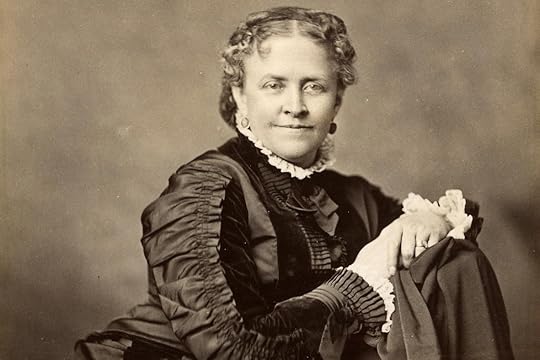
. . . . . . . . . .
A shattered life
Suddenly, like a thunderbolt from a clear sky, the happy life was shattered. Major Hunt was killed Oct. 2, 1863, while experimenting in Brooklyn with a submarine gun of his own invention.
The young widow still had her eight-year-old boy, and she clung to him more tenderly than ever. But in less than two years, she stood by his dying bed. Seeing the agony of his mother, and forgetting his own even in that dread destroyer, diphtheria, he said, almost at the last moment, “Promise me, mamma, that you will not kill yourself.”
She promised, and exacted from him also a pledge that if it were possible, he would come back from the other world to talk with his mother. He never came, and Mrs. Hunt could have no faith in spiritualism because what Rennie could not do, she believed to be impossible.
For months she shut herself into her room, refusing to see her nearest friends. “Anyone who really loves me ought to pray that I may die, too, like Rennie,” she said. Her physician thought she would die of grief; but when her strong, earnest nature had wrestled with itself and come off conqueror, she came out of her seclusion, cheerful as of old. The pictures of her husband and boy were ever beside her, and these doubtless spurred her on to the work she was to accomplish.
A bereaved mother’s poem
Three months after Rennie’s death, her first poem, Lifted Over, appeared in the Nation:
As tender mothers, guiding baby steps,
When places come at which the tiny feet
Would trip, lift up the little ones in arms
Of love, and set them down beyond the harm,
So did our Father watch the precious boy,
Led o’er the stones by me, who stumbled oft
Myself, but strove to help my darling on:
He saw the sweet limbs faltering, and saw
Rough ways before us, where my arms would fail;
So reached from heaven, and lifting the dear child,
Who smiled in leaving me, He put him down
Beyond all hurt, beyond my sight, and bade
Him wait for me! Shall I not then be glad,
And, thanking God, press on to overtake!”
The poem was widely copied, and many mothers were comforted by it. The kind letters she received in consequence were the first gleam of sunshine in the darkened life. If she were doing even a little good, she could live and be strong.
. . . . . . . . . .
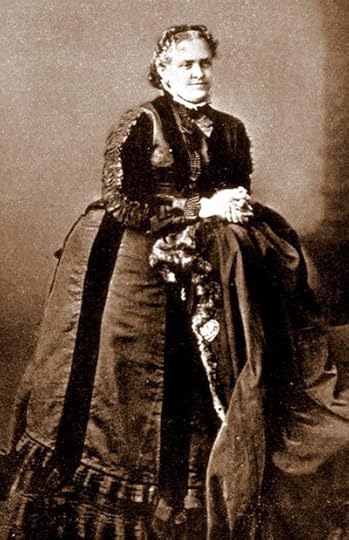
. . . . . . . . . .
The start of a literary career
Then began, at thirty-four, absorbing and painstaking literary work. She studied the best models of composition and found it most helpful to study the works of Wentworth Higginson.
Her first prose sketch, “A Walk Up Mt. Washington from the Glen House,” appeared in the Independent, Sept. 13, 1866; and from this time she wrote for that able journal three hundred and seventy-one articles.
She worked rapidly, writing usually with a lead-pencil, on large sheets of yellow paper, but she pruned carefully. Her first poem in the Atlantic Monthly, entitled Coronation, delicate and full of meaning, appeared in 1869, being taken to Mr. Fields, the editor, by a friend.
At this time she spent a year abroad, principally in Germany and Italy, writing home several sketches. In Rome, she became so ill that her life hung by a thread. When she was partially recovered and went away to regain her strength, her friends insisted that a professional nurse should go with her; but she took a hard-working young Italian girl of sixteen, to whom this vacation would be a blessing.
First publications
In 1870, on Helen’s return from Europe, a little book of Verses was published. Like most beginners, she was obliged to pay for the stereotyped plates. The book was well received. Ralph Waldo Emerson liked especially her sonnet, Thought. He ranked her poetry above that of all American women, and most American men.
Some persons praised the “exquisite musical structure” of “Gondoliers,” and others read and re-read her beautiful “Down to Sleep.” But the world’s favorite was “Spinning”:
Like a blind spinner in the sun,
I tread my days;
I know that all the threads will run
Appointed ways;
I know each day will bring its task,
And, being blind, no more I ask.
But listen, listen, day by day,
To hear their tread
Who bear the finished web away,
And cut the thread,
And bring God’s message in the sun,
“Thou poor blind spinner, work is done.’
After this came two other small books, Bits of Travel and Bits of Talk about Home Matters. She paid for the plates of the former. Fame did not burst upon Helen Hunt; it came after years of work after it had been fully earned. The road to authorship is a hard one, and only those should attempt it who have courage and perseverance.
A second marriage
Eleven years after the death of Major Hunt, in 1876, Helen married Mr. William Sharpless Jackson, a Quaker and a cultured banker. Their home in Colorado Springs, became an ideal one, sheltered under the great Manitou, and looking toward the Garden of the Gods, full of books and magazines, of dainty rugs and dainty china gathered from many countries, and richly colored Colorado flowers.
The new Mrs. Jackson loved flowers almost as though they were children. She wrote:
“I bore on this June day a sheaf of the white columbine — one single sheaf, one single root; but it was almost more than I could carry. In the open spaces, I carried it on my shoulder; in the thickets, I bore it carefully in my arms, like a baby …
There is a part of Cheyenne Mountain which I and one other have come to call ‘our garden.’ When we drive down from ‘our garden,’ there is seldom room for another flower in our carriage. The top thrown back is filled, the space in front of the driver is filled, and our laps and baskets are filled with the more delicate blossoms.
We look as if we were on our way to the ceremonies of Decoration Day. So we are. All June days are decoration days in Colorado Springs, but it is the sacred joy of life that we decorate — not the sacred sadness of death.”
. . . . . . . . . .
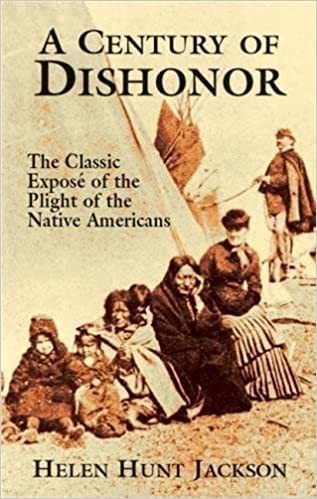
. . . . . . . . . .
A budding novelist and advocate for Native Americans
But Mrs. Jackson, with her pleasant home, could not rest from her work. Two novels came from her pen, Mercy Philbrick’s Choice and Hetty’s Strange History. It is probable also that she helped to write the beautiful and tender Saxe Holm Stories.
The time had now come for her to do her last and perhaps her best work. She could not write without a definite purpose, and now the purpose that settled down upon her heart was to help the defrauded Indians.
She left her home and spent three months in the Astor Library of New York, writing her Century of Dishonor, showing how we have despoiled the Indians and broken our treaties with them. She wrote to a friend, “I cannot think of anything else from night to morning and from morning to night.” So untiringly did she work that she made herself ill.
At her own expense, she sent a copy to each member of Congress. Its plain facts were not relished in some quarters, and she began to taste the cup that all reformers have to drink; but the brave woman never flinched in her duty. So much was the Government impressed by her earnestness and good judgment, that she was appointed a Special Commissioner with her friend, Abbott Kinney, to examine and report on the condition of the Mission Indians in California.
Could an accomplished, tenderly reared woman go into their adobe villages and listen to their wrongs? What would the world say of its poet? Mrs. Jackson did not ask; she had a mission to perform, and the more culture, the more responsibility. She brought cheer and hope to the Native American men and their wives, and they called her “the Queen.” She wrote able articles about them in the Century.
The report made by Mr. Kinney and herself, which she prepared largely, was clear and convincing. How different all this from her early life! Mrs. Jackson had become more than a poet and novelist; even the leader of an oppressed people.
At once, in the winter of 1883, she began to write her wonderfully graphic and tender Ramona, and into this, she said, “I put my heart and soul.” The book was immediately reprinted in England, and has had great popularity. She meant to do for the American Indian what Mrs. Stowe did for the slave, and she lived long enough to see the great work well in progress.
An injury and last letters
In June 1884, falling on the staircase of her Colorado home, she severely fractured her leg and was confined to the house for several months. Then she was taken to Los Angeles for the winter. The broken limb mended rapidly, but malarial fever set in, and she was carried to San Francisco. Her first remark was, as she entered the house looking out upon the broad and lovely bay, “I did not imagine it was so pleasant! What a beautiful place to die in!”
To the last, her letters to her friends were full of cheer. She wrote:
“You must not think because I speak of not getting well that I am sad over it,” she wrote. “On the contrary, I am more and more relieved in my mind, as it seems to grow more and more sure that I shall die. You see that I am growing old [she was but fifty-four], and I do believe that my work is done.
You have never realized how, for the past five years, my whole soul has been centered on the Indian question. Ramona was the outcome of those five years. The Indian cause is on its feet now; powerful friends are at work.”
To another, she wrote:
“I am heartily, honestly, and cheerfully ready to go. In fact, I am glad to go. My Century of Dishonor and Ramona are the only things I have done of which I am glad now. The rest is of no moment. They will live, and they will bear fruit. They already have. The change in public feeling on the Indian question in the last three years is marvelous; an Indian Rights Association in every large city in the land.”
She had no fear of death. She said, “It is only just passing from one country to another … My only regret is that I have not accomplished more work; especially that it was so late in the day when I began to work in real earnest.”
A peaceful departure
Four days before she died, she wrote to President Cleveland:
“From my death-bed I send you a message of heartfelt thanks for what you have already done for the Indians. I ask you to read my Century of Dishonor. I am dying happier for the belief I have that it is your hand that is destined to strike the first steady blow toward lifting this burden of infamy from our country, and righting the wrongs of the Indian race.
With respect and gratitude, Helen Jackson”
That evening, Aug. 8, after saying farewell, she placed her hand in her husband’s, and went to sleep. After four days, mostly unconscious ones, she wakened in eternity.
On her coffin were laid a few simple clover-blossoms, flowers she loved in life; and then, near the summit of Cheyenne Mountain, four miles from Colorado Springs, in a spot of her own choosing, she was buried.
Do not adorn with costly shrub or tree
Or flower the little grave which shelters me.
Let the wild wind-sown seeds grow up unharmed,
And back and forth all summer, unalarmed,
Let all the tiny, busy creatures creep;
Let the sweet grass its last year’s tangles keep;
And when, remembering me, you come some day
And stand there, speak no praise, but only say,
‘How she loved us! It was for that she was so dear.’
These are the only words that I shall smile to hear.
. . . . . . . . . .
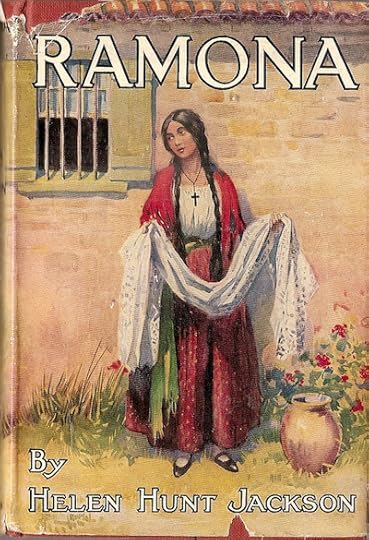
. . . . . . . . . .
Helen Hunt Jackson’s legacy
All honor a woman who, with a happy home, was willing to leave it to make other homes happy; who, having suffered, tried with a sympathetic heart to forget herself and keep others from suffering; who, being famous, gladly took time to help unknown authors to win fame; who, having means, preferred a life of labor to a life of ease.
Helen Hunt Jackson’s work was republished in numerous editions, reaching generations of readers, especially with Century of Dishonor and Ramona. Zeph, a touching story of frontier life in Colorado, which she finished in her last illness, was also widely read. Her sketches of travel have been gathered into Glimpses of Three Coasts, and a posthumous volume of poems, Sonnets and Lyrics, was published.
. . . . . . . . . .

Helen Hunt Jackson Memorial in Seven Falls, Colorado
More about Helen Hunt Jackson
Schools, libraries, portions of parks, and more, have been named in honor of Helen Hunt Jackson’s legacy. A majority of her papers are archived at Colorado College, and some of her papers are also archived in the NY Public Library, She was inducted into the Colorado Women’s Hall of Fame in 1985
Selected works
Bits of Travel (1872)
Bits about Home Matters (1873)
Saxe Holm’s Stories (1874)
The Story of Boon (1874)
Mercy Philbrick’s Choice (1876)
Hetty’s Strange History (1877)
Bits of Talk in Verse and Prose for Young Folks (1876)
Bits of Travel at Home (1878)
Nelly’s Silver Mine: A Story of Colorado Life (1878)
Letters from a Cat (1879)
A Century of Dishonor (1881)
Ramona (1884)
Zeph: A Posthumous Story (1885)
Glimpses of Three Coasts (1886)
Between Whiles (1888)
A Calendar of Sonnets (1891)
Ryan Thomas (1892)
The Hunter Cats of Connorloa (1894)
Poems by Helen Jackson Roberts Bros, Boston (1893)
Pansy Billings and Popsy: Two Stories of Girl Life (1898)
Glimpses of California (1914)
Biographies
Helen Hunt Jackson by Ruth Webb O’Dell, 1939
Helen Hunt Jackson by Evelyn I. Banning, 1973
Helen Hunt Jackson: A Lonely Voice of Conscience by Antoinette May, 1987
Valerie Sherer Mathes, Helen Hunt Jackson and Her Indian Reform Legacy, 1992
Helen Hunt Jackson: Selected Colorado Writings, Mark I. West., ed., 2002
Helen Hunt Jackson: A Literary Life, Kate Phillips, 2003
Indian Reform Letters of Helen Hunt Jackson, 1879 – 1885, Valerie Sherer Mathes, ed., 2015
Read and listen online
Helen Hunt Jackson’s works on Project Gutenberg
Listen to audio versions on Librivox
More information and Sources
Wikipedia
Poetry Foundation
Reader discussion of Helen Hunt Jackson’s works on Goodreads
Helen Hunt Jackson papers at Colorado College
. . . . . . . . . .
The post Helen Hunt Jackson appeared first on Literary Ladies Guide.
November 25, 2020
Nets to Catch the Wind by Elinor Wylie (1921) – full text
Elinor Wylie (1885- 1928) was an American poet and novelist who had her heyday in the 1920s and 1930s. Her poetry was considered by some a modern successor to the romantic poets, and she was compared favorably with John Donne and Percy Shelley. Following is the full text of Nets to Catch the Wind (1921), her first officially published collection.
In her lifetime, she was celebrated nearly as much for her ethereal beauty and charm as for her talent. Her love life was marked by heartbreak, multiple marriages, and affairs.
Born Elinor Morton, she was stalked for years by the much-older Horace Wylie, a married attorney and father of three. Given her ultimate renown under the name Elinor Wylie, she might have echoed the immortal line by Charlotte Brontë’s Jane Eyre — “Reader, I married him” — but with greater scandal.
Wylie anonymously self-published her first collection of poems, Incidental Numbers, in 1912. Nets to Catch the Wind, her first traditionally published poetry collection, appeared in 1921. Some five subsequent collections were published in her lifetime (never in the best of health, she died at age 43), with more collections that came out posthumously.
Learn more about Elinor Wylie and read more of her poetry:
Poetry Foundation
The Other Pages
Listen to Elinor Wylie’s poetry on Librivox
Here is the complete text of Nets to Catch the Wind (1921), which is in the public domain.
. . . . . . . . . . .
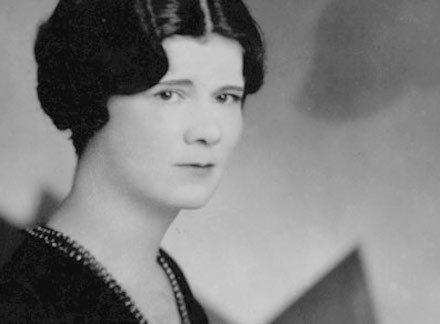
. . . . . . . . . .
Nets to Catch the Wind by Elinor Wylie
BEAUTY
Say not of Beauty she is good,
Or aught but beautiful,
Or sleek to doves’ wings of the wood
Her wild wings of a gull.
Call her not wicked; that word’s touch
Consumes her like a curse;
But love her not too much, too much,
For that is even worse.
O, she is neither good nor bad,
But innocent and wild!
Enshrine her and she dies, who had
The hard heart of a child.
. . . . . . . . . . .
THE EAGLE AND THE MOLE
Avoid the reeking herd,
Shun the polluted flock,
Live like that stoic bird,
The eagle of the rock.
The huddled warmth of crowds
Begets and fosters hate;
He keeps, above the clouds,
His cliff inviolate.
When flocks are folded warm,
And herds to shelter run,
He sails above the storm,
He stares into the sun.
If in the eagle’s track
Your sinews cannot leap,
Avoid the lathered pack,
Turn from the steaming sheep.
If you would keep your soul
From spotted sight or sound,
Live like the velvet mole;
Go burrow underground.
And there hold intercourse
With roots of trees and stones,
With rivers at their source,
And disembodied bones.
. . . . . . . . . . .
MADMAN’S SONG
Better to see your cheek grown hollow,
Better to see your temple worn,
Than to forget to follow, follow,
After the sound of a silver horn.
Better to bind your brow with willow
And follow, follow until you die,
Than to sleep with your head on a golden pillow,
Nor lift it up when the hunt goes by.
Better to see your cheek grown sallow
And your hair grown gray, so soon, so soon,
Than to forget to hallo, hallo,
After the milk-white hounds of the moon.
. . . . . . . . . . .
THE PRINKIN’ LEDDIE
“The Hielan’ lassies are a’ for spinnin’
The Lowlan’ lassies for prinkin’ and pinnin’;
My daddie w’u’d chide me, an’ so w’u’d my minnie
If I s’u’d bring hame sic a prinkin’ leddie.”_
Now haud your tongue, ye haverin’ coward,
For whilst I’m young I’ll go flounced an’ flowered,
In lutestring striped like the strings o’ a fiddle,
Wi’ gowden girdles aboot my middle.
In your Hielan’ glen, where the rain pours steady,
Ye’ll be gay an’ glad for a prinkin’ leddie;
Where the rocks are all bare an’ the turf is all sodden,
An’ lassies gae sad in their homespun an’ hodden.
My silks are stiff wi’ patterns o’ siller,
I’ve an ermine hood like the hat o’ a miller,
I’ve chains o’ coral like rowan berries,
An’ a cramoisie mantle that cam’ frae Paris.
Ye’ll be glad for the glint o’ its scarlet linin’
When the larks are up an’ the sun is shinin’;
When the winds are up an’ ower the heather
Your heart’ll be gay wi’ my gowden feather.
When the skies are low an’ the earth is frozen,
Ye’ll be gay an’ glad for the leddie ye’ve chosen,
When ower the snow I go prinkin’ an’ prancin’
In my wee red slippers were made for dancin’.
It’s better a leddie like Solomon’s lily
Than one that’ll run like a Hielan’ gillie
A-linkin’ it ower the leas, my laddie,
In a raggedy kilt an’ a belted plaidie!
. . . . . . . . . . .
AUGUST
Why should this Negro insolently stride
Down the red noonday on such noiseless feet?
Piled in his barrow, tawnier than wheat,
Lie heaps of smoldering daisies, somber-eyed,
Their copper petals shriveled up with pride,
Hot with a superfluity of heat,
Like a great brazier borne along the street
By captive leopards, black and burning pied.
Are there no water-lilies, smooth as cream,
With long stems dripping crystal? Are there none
Like those white lilies, luminous and cool,
Plucked from some hemlock-darkened northern stream
By fair-haired swimmers, diving where the sun
Scarce warms the surface of the deepest pool?
. . . . . . . . . . .
THE CROOKED STICK
First Traveler: What’s that lying in the dust?
Second Traveler: A crooked stick.
First Traveler: What’s it worth, if you can trust
To arithmetic?
Second Traveler: Isn’t this a riddle?
First Traveler: No, a trick.
Second Traveler: It’s worthless. Leave it where it lies.
First Traveler: Wait; count ten;
Rub a little dust upon your eyes;
Now, look again.
Second Traveler: Well, and what the devil is it, then?
First Traveler: It’s the sort of crooked stick that shepherds know.
Second Traveler: Some one’s loss!
First Traveler: Bend it, and you make of it a bow.
Break it, a cross.
Second Traveler: But it’s all grown over with moss!
. . . . . . . . . . .
ATAVISM
I always was afraid of Somes’s Pond:
Not the little pond, by which the willow stands,
Where laughing boys catch alewives in their hands
In brown, bright shallows; but the one beyond.
There, when the frost makes all the birches burn
Yellow as cow-lilies, and the pale sky shines
Like a polished shell between black spruce and pines,
Some strange thing tracks us, turning where we turn.
You’ll say I dream it, being the true daughter
Of those who in old times endured this dread.
Look! Where the lily-stems are showing red
A silent paddle moves below the water,
A sliding shape has stirred them like a breath;
Tall plumes surmount a painted mask of death.
. . . . . . . . . . .
WILD PEACHES
1
When the world turns completely upside down
You say we’ll emigrate to the Eastern Shore
Aboard a river-boat from Baltimore;
We’ll live among wild peach trees, miles from town.
You’ll wear a coonskin cap, and I a gown
Homespun, dyed butternut’s dark gold color.
Lost, like your lotus-eating ancestor,
We’ll swim in milk and honey till we drown.
The winter will be short, the summer long,
The autumn amber-hued, sunny and hot,
Tasting of cider and of scuppernong;
All seasons sweet, but autumn best of all.
The squirrels in their silver fur will fall
Like falling leaves, like fruit, before your shot.
2
The autumn frosts will lie upon the grass
Like bloom on grapes of purple-brown and gold.
The misted early mornings will be cold;
The little puddles will be roofed with glass.
The sun, which burns from copper into brass,
Melts these at noon, and makes the boys unfold
Their knitted mufflers; full as they can hold,
Fat pockets dribble chestnuts as they pass.
Peaches grow wild, and pigs can live in clover;
A barrel of salted herrings lasts a year;
The spring begins before the winter’s over.
By February you may find the skins
Of garter snakes and water moccasins
Dwindled and harsh, dead-white and cloudy-clear.
3
When April pours the colors of a shell
Upon the hills, when every little creek
Is shot with silver from the Chesapeake
In shoals new-minted by the ocean swell,
When strawberries go begging, and the sleek
Blue plums lie open to the blackbird’s beak,
We shall live well–we shall live very well.
The months between the cherries and the peaches
Are brimming cornucopias which spill
Fruits red and purple, somber-bloomed and black;
Then, down rich fields and frosty river beaches
We’ll trample bright persimmons, while we kill
Bronze partridge, speckled quail, and canvas-back.
4
Down to the Puritan marrow of my bones
There’s something in this richness that I hate.
I love the look, austere, immaculate,
Of landscapes drawn in pearly monotones.
There’s something in my very blood that owns
Bare hills, cold silver on a sky of slate,
A thread of water, churned to milky spate
Streaming through slanted pastures fenced with stones.
I love those skies, thin blue or snowy gray,
Those fields sparse-planted, rendering meager sheaves;
That spring, briefer than apple-blossom’s breath,
Summer, so much too beautiful to stay,
Swift autumn, like a bonfire of leaves,
And sleepy winter, like the sleep of death.
. . . . . . . . . . .
SANCTUARY
This is the bricklayer; hear the thud
Of his heavy load dumped down on stone.
His lustrous bricks are brighter than blood,
His smoking mortar whiter than bone.
Set each sharp-edged, fire-bitten brick
Straight by the plumb-line’s shivering length;
Make my marvelous wall so thick
Dead nor living may shake its strength.
Full as a crystal cup with drink
Is my cell with dreams, and quiet, and cool …
Stop, old man! You must leave a chink;
How can I breathe? You can’t, you fool!
. . . . . . . . . . .
THE LION AND THE LAMB
I saw a Tiger’s golden flank,
I saw what food he ate,
By a desert spring he drank;
The Tiger’s name was Hate.
Then I saw a placid Lamb
Lying fast asleep;
Like a river from its dam
Flashed the Tiger’s leap.
I saw a Lion tawny-red,
Terrible and brave;
The Tiger’s leap overhead
Broke like a wave.
In sand below or sun above
He faded like a flame.
The Lamb said, “I am Love”;
“Lion, tell your name.”
The Lion’s voice thundering
Shook his vaulted breast,
“I am Love. By this spring,
Brother, let us rest.”
. . . . . . . . . . .
THE CHURCH-BELL
As I was lying in my bed
I heard the church-bell ring;
Before one solemn word was said
A bird began to sing.
I heard a dog begin to bark
And a bold crowing cock;
The bell, between the cold and dark,
Tolled. It was five o’clock.
The church-bell tolled, and the bird sang,
A clear true voice he had;
The cock crew, and the church-bell rang,
I knew it had gone mad.
A hand reached down from the dark skies,
It took the bell-rope thong,
The bell cried “Look! Lift up your eyes!”
The clapper shook to song.
The iron clapper laughed aloud,
Like clashing wind and wave;
The bell cried out “Be strong and proud!”
Then, with a shout, “Be brave!”
The rumbling of the market-carts,
The pounding of men’s feet
Were drowned in song; “Lift up your hearts!”
The sound was loud and sweet.
Slow and slow the great bell swung,
It hung in the steeple mute;
And people tore its living tongue
Out by the very root.
. . . . . . . . . . .
A CROWDED TROLLEY CAR
The rain’s cold grains are silver-gray
Sharp as golden sands,
A bell is clanging, people sway
Hanging by their hands.
Supple hands, or gnarled and stiff,
Snatch and catch and grope;
That face is yellow-pale, as if
The fellow swung from rope.
Dull like pebbles, sharp like knives,
Glances strike and glare,
Fingers tangle, Bluebeard’s wives
Dangle by the hair.
Orchard of the strangest fruits
Hanging from the skies;
Brothers, yet insensate brutes
Who fear each others’ eyes.
One man stands as free men stand,
As if his soul might be
Brave, unbroken; see his hand
Nailed to an oaken tree.
. . . . . . . . . . .
BELLS IN THE RAIN
Sleep falls, with limpid drops of rain,
Upon the steep cliffs of the town.
Sleep falls; men are at peace again
Awhile the small drops fall softly down.
The bright drops ring like bells of glass
Thinned by the wind, and lightly blown;
Sleep cannot fall on peaceful grass
So softly as it falls on stone.
Peace falls unheeded on the dead
Asleep; they have had deep peace to drink;
Upon a live man’s bloody head
It falls most tenderly, I think.
. . . . . . . . . . .
WINTER SLEEP
When against earth a wooden heel
Clicks as loud as stone and steel,
When snow turns flour instead of flakes,
And frost bakes clay as fire bakes,
When the hard-bitten fields at last
Crack like iron flawed in the cast,
When the world is wicked and cross and old,
I long to be quit of the cruel cold.
Little birds like bubbles of glass
Fly to other Americas,
Birds as bright as sparkles of wine
Fly in the night to the Argentine,
Birds of azure and flame-birds go
To the tropical Gulf of Mexico:
They chase the sun, they follow the heat,
It is sweet in their bones, O sweet, sweet, sweet!
It’s not with them that I’d love to be,
But under the roots of the balsam tree.
Just as the spiniest chestnut-burr
Is lined within with the finest fur,
So the stony-walled, snow-roofed house
Of every squirrel and mole and mouse
Is lined with thistledown, sea-gull’s feather,
Velvet mullein-leaf, heaped together
With balsam and juniper, dry and curled,
Sweeter than anything else in the world.
O what a warm and darksome nest
Where the wildest things are hidden to rest!
It’s there that I’d love to lie and sleep,
Soft, soft, soft, and deep, deep, deep!
. . . . . . . . . . .
VILLAGE MYSTERY
The woman in the pointed hood
And cloak blue-gray like a pigeon’s wing,
Whose orchard climbs to the balsam-wood,
Has done a cruel thing.
To her back door-step came a ghost,
A girl who had been ten years dead,
She stood by the granite hitching-post
And begged for a piece of bread.
Now why should I, who walk alone,
Who am ironical and proud,
Turn, when a woman casts a stone
At a beggar in a shroud?
I saw the dead girl cringe and whine,
And cower in the weeping air–
But, oh, she was no kin of mine,
And so I did not care!
. . . . . . . . . . .
SUNSET ON THE SPIRE
All that I dream
By day or night
Lives in that stream
Of lovely light.
Here is the earth,
And there is the spire;
This is my hearth,
And that is my fire.
From the sun’s dome
I am shouted proof
That this is my home,
And that is my roof.
Here is my food,
And here is my drink,
And I am wooed
From the moon’s brink.
And the days go over,
And the nights end;
Here is my lover,
Here is my friend.
All that I
Could ever ask
Wears that sky
Like a thin gold mask.
. . . . . . . . . . .
ESCAPE
When foxes eat the last gold grape,
And the last white antelope is killed,
I shall stop fighting and escape
Into a little house I’ll build.
But first I’ll shrink to fairy size,
With a whisper no one understands,
Making blind moons of all your eyes,
And muddy roads of all your hands.
And you may grope for me in vain
In hollows under the mangrove root,
Or where, in apple-scented rain,
The silver wasp-nests hang like fruit.
. . . . . . . . . . .
THE FAIRY GOLDSMITH
Here’s a wonderful thing,
A humming-bird’s wing
In hammered gold,
And store well chosen
Of snowflakes frozen
In crystal cold.
Black onyx cherries
And mistletoe berries
Of chrysoprase,
Jade buds, tight shut,
All carven and cut
In intricate ways.
Here, if you please
Are little gilt bees
In amber drops
Which look like honey,
Translucent and sunny,
From clover-tops.
Here’s an elfin girl
Of mother-of-pearl
And moonshine made,
With tortoise-shell hair
Both dusky and fair
In its light and shade.
Here’s lacquer laid thin,
Like a scarlet skin
On an ivory fruit;
And a filigree frost
Of frail notes lost
From a fairy lute.
Here’s a turquoise chain
Of sun-shower rain
To wear if you wish;
And glimmering green
With aquamarine,
A silvery fish.
Here are pearls all strung
On a thread among
Pretty pink shells;
And bubbles blown
From the opal stone
Which ring like bells.
Touch them and take them,
But do not break them!
Beneath your hand
They will wither like foam
If you carry them home
Out of fairy-land.
O, they never can last
Though you hide them fast
From moth and from rust;
In your monstrous day
They will crumble away
Into quicksilver dust.
. . . . . . . . . . .
“FIRE AND SLEET AND CANDLELIGHT”
For this you’ve striven
Daring, to fail:
Your sky is riven
Like a tearing veil.
For this, you’ve wasted
Wings of your youth;
Divined, and tasted
Bitter springs of truth.
From sand unslaked
Twisted strong cords,
And wandered naked
Among trysted swords.
There’s a word unspoken,
A knot untied.
Whatever is broken
The earth may hide.
The road was jagged
Over sharp stones:
Your body’s too ragged
To cover your bones.
The wind scatters
Tears upon dust;
Your soul’s in tatters
Where the spears thrust.
Your race is ended–
See, it is run:
Nothing is mended
Under the sun.
Straight as an arrow
You fall to a sleep
Not too narrow
And not too deep.
. . . . . . . . . . .
BLOOD FEUD
Once, when my husband was a child, there came
To his father’s table, one who called him kin,
In sunbleached corduroys paler than his skin.
His look was grave and kind; he bore the name
Of the dead singer of Senlac, and his smile.
Shyly and courteously he smiled and spoke;
“I’ve been in the laurel since the winter broke;
Four months, I reckon; yes, sir, quite a while.”
He’d killed a score of foemen in the past,
In some blood-feud, a dark and monstrous thing;
To him it seemed his duty. At the last
His enemies found him by a forest spring,
Which, as he died, lay bright beneath his head,
A silver shield that slowly turned to red.
. . . . . . . . . . .
SEA LULLABY
The old moon is tarnished
With smoke of the flood,
The dead leaves are varnished
With color like blood,
A treacherous smiler
With teeth white as milk,
A savage beguiler
In sheathings of silk,
The sea creeps to pillage,
She leaps on her prey;
A child of the village
Was murdered to-day.
She came up to meet him
In a smooth golden cloak,
She choked him and beat him
To death, for a joke.
Her bright locks were tangled,
She shouted for joy,
With one hand she strangled
A strong little boy.
Now in silence she lingers
Beside him all night
To wash her long fingers
In silvery light.
. . . . . . . . . . .
NANCY
You are a rose, but set with sharpest spine;
You are a pretty bird that pecks at me;
You are a little squirrel on a tree,
Pelting me with the prickly fruit of the pine;
A diamond, torn from a crystal mine,
Not like that milky treasure of the sea
A smooth, translucent pearl, but skilfully
Carven to cut, and faceted to shine.
If you are flame, it dances and burns blue;
If you are light, it pierces like a star
Intenser than a needlepoint of ice.
The dexterous touch that shaped the soul of you,
Mingled, to mix, and make you what you are,
Magic between the sugar and the spice.
. . . . . . . . . . .
A PROUD LADY
Hate in the world’s hand
Can carve and set its seal
Like the strong blast of sand
Which cuts into steel.
I have seen how the finger of hate
Can mar and mold
Faces burned passionate
And frozen cold.
Sorrowful faces worn
As stone with rain,
Faces writhing with scorn
And sullen with pain.
But you have a proud face
Which the world cannot harm,
You have turned the pain to a grace
And the scorn to a charm.
You have taken the arrows and slings
Which prick and bruise
And fashioned them into wings
For the heels of your shoes.
From the world’s hand which tries
To tear you apart
You have stolen the falcon’s eyes
And the lion’s heart.
What has it done, this world,
With hard finger tips,
But sweetly chiseled and curled
Your inscrutable lips?
. . . . . . . . . . .
THE TORTOISE IN ETERNITY
Within my house of patterned horn
I sleep in such a bed
As men may keep before they’re born
And after they are dead.
Sticks and stones may break their bones,
And words may make them bleed;
There is not one of them who owns
An armor to his need.
Tougher than hide or lozenged bark,
Snow-storm and thunder proof,
And quick with sun, and thick with dark,
Is this my darling roof.
Men’s troubled dreams of death and birth
Pulse mother-o’-pearl to black;
I bear the rainbow bubble Earth
Square on my scornful back.
. . . . . . . . . . .
INCANTATION
A white well
In a black cave;
A bright shell
In a dark wave.
A white rose
Black brambles hood;
Smooth bright snows
In a dark wood.
A flung white glove
In a dark fight;
A white dove
On a wild black night.
A white door
In a dark lane;
A bright core
To bitter black pain.
A white hand
Waved from dark walls;
In a burnt black land
Bright waterfalls.
A bright spark
Where black ashes are;
In the smothering dark
One white star.
. . . . . . . . . . .
SILVER FILIGREE
The icicles wreathing
On trees in festoon
Swing, swayed to our breathing:
They’re made of the moon.
She’s a pale, waxen taper;
And these seem to drip
Transparent as paper
From the flame of her tip.
Molten, smoking a little,
Into crystal they pass;
Falling, freezing, to brittle
And delicate glass.
Each a sharp-pointed flower,
Each a brief stalactite
Which hangs for an hour
In the blue cave of night.
. . . . . . . . . . .
THE FALCON
Why should my sleepy heart be taught
To whistle mocking-bird replies?
This is another bird you’ve caught,
Soft-feathered, with a falcon’s eyes.
The bird Imagination,
That flies so far, that dies so soon;
Her wings are colored like the sun,
Her breast is colored like the moon.
Weave her a chain of silver twist,
And a little hood of scarlet wool,
And let her perch upon your wrist,
And tell her she is beautiful.
. . . . . . . . . . .
BRONZE TRUMPETS AND SEA WATER—
ON TURNING LATIN INTO ENGLISH
Alembics turn to stranger things
Strange things, but never while we live
Shall magic turn this bronze that sings
To singing water in a sieve.
The trumpeters of Caesar’s guard
Salute his rigorous bastions
With ordered bruit; the bronze is hard
Though there is silver in the bronze.
Our mutable tongue is like the sea,
Curled wave and shattering thunder-fit;
Dangle in strings of sand shall be
Who smooths the ripples out of it.
. . . . . . . . . . .
SPRING PASTORAL
Liza, go steep your long white hands
In the cool waters of that spring
Which bubbles up through shiny sands
The color of a wild-dove’s wing.
Dabble your hands, and steep them well
Until those nails are pearly white
Now rosier than a laurel bell;
Then come to me at candle-light.
Lay your cold hands across my brows,
And I shall sleep, and I shall dream
Of silver-pointed willow boughs
Dipping their fingers in a stream.
. . . . . . . . . . .
VELVET SHOES
Let us walk in the white snow
In a soundless space;
With footsteps quiet and slow,
At a tranquil pace,
Under veils of white lace.
I shall go shod in silk,
And you in wool,
White as a white cow’s milk,
More beautiful
Than the breast of a gull.
We shall walk through the still town
In a windless peace;
We shall step upon white down,
Upon silver fleece,
Upon softer than these.
We shall walk in velvet shoes:
Wherever we go
Silence will fall like dews
On white silence below.
We shall walk in the snow.
. . . . . . . . . . .
VALENTINE
Too high, too high to pluck
My heart shall swing.
A fruit no bee shall suck,
No wasp shall sting.
If on some night of cold
It falls to ground
In apple-leaves of gold
I’ll wrap it round.
And I shall seal it up
With spice and salt,
In a carven silver cup,
In a deep vault.
Before my eyes are blind
And my lips mute,
I must eat core and rind
Of that same fruit.
Before my heart is dust
At the end of all,
Eat it I must, I must
Were it bitter gall.
But I shall keep it sweet
By some strange art;
Wild honey I shall eat
When I eat my heart.
O honey cool and chaste
As clover’s breath!
Sweet Heaven I shall taste
Before my death.
The post Nets to Catch the Wind by Elinor Wylie (1921) – full text appeared first on Literary Ladies Guide.
November 20, 2020
Hungry Hill by Daphne du Maurier (1943)
Hungry Hill by Daphne du Maurier is a 1943 novel by the prolific British author and playwright. Her seventh novel takes the form of a multigenerational family saga taking place from 1820 to 1920.
Inspired by actual events and places, the story follows the fortunes of the Brodricks, Anglo-Irish landowners who inhabit Clonmere castle.
While Hungry Hill hasn’t remained as well-known as some of du Maurier’s more famous novels, notably Rebecca, My Cousin Rachel, Jamaica Inn, Frenchman’s Creek, and The Scapegoat, it was successful in its time. It went through dozens of editions, and like many of du Maurier’s other works, it was adapted to film. However, the 1947 movie version was roundly panned.
Hungry Hill was re-released in 2008 by Virago Press. From the publisher:
“Hungry Hill is a passionate story told with du Maurier’s unique gift for drama. It follows five generations of an Irish family and the copper mine on Hungry Hill to which their fortunes and fates are bound.
‘I tell you your mine will be in ruins and your home destroyed and your children forgotten . . . but this hill will be standing still to confound you.’ So curses Morty Donovan when ‘Copper John’ Brodrick builds his mine at Hungry Hill.
The Brodricks of Clonmere gain great wealth by harnessing the power of Hungry Hill and extracting the treasure it holds. The Donovans, the original owners of Clonmere Castle, resent the Brodricks’ success, and consider the great house and its surrounding land theirs by rights.
For generations the feud between the families has simmered, always threatening to break into violence …”
. . . . . . . . . . .
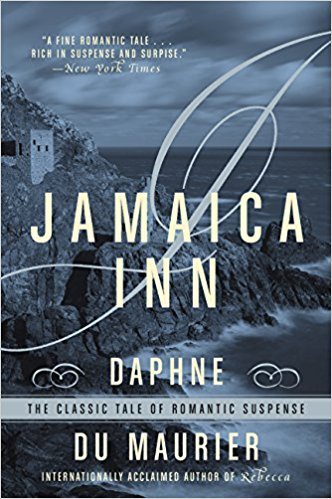
You might also like: 6 Essential Novels by Daphne du Maurier
. . . . . . . . . . .
A 1943 review of Hungry Hill
From the original review in The Journal Herald – Dayton, Ohio, June 20, 1943. Reviewed by Margaret Ann Ahlers.
The author of Rebecca, Jamaica Inn, and Frenchman’s Creek has achieved a work of broad scope and dramatic power; she has created a fine novel on considerably larger scale than her previous ones.
Du Maurier writes with much skill; her characters are never hard to discern and in this book, she pictures the Irish countryside and the dominant snow-capped Hungry Hill with most enjoyable clarity.
Landowners arouse resentment
The Broderick family were aristocratic landowners whose arrogance and prosperity continually aroused the resentment of their tenants, the Donovans, who looked upon them as intruders. For generations, the poor Irish who lived in Doonhaven had considered that they themselves were the first holders of the land from which the Brodricks derived their wealth.
And while when face to face the Donovans showed proper respect for their landlord, it was the undercurrent of bitterness which eventually cropped out and made trouble. In the early years of the feud it was a Donovan who shot the father of John Brodrick, owner of the fine estate of Clonmere, one of the chief scenes of the story.
The old trouble flares again when at the very beginning of the novel, John Brodrick makes known his decision to open a copper mine in the side of Hungry Hill and take for himself and his family the hidden wealth he knew to be there.
The news spread fast and though the new mine would mean occupation for all the men and boys of the vicinity, the announcement was not well received. When John Brodrick met Morty Donovan on the road the day the agreement was signed with his partner, Robert Lumley, Donovan was frank to say to his landlord that no good would come of the mine.
“You should have asked permission of the hill first, Mr. Brodrick,” he said. “Aye, you can laugh, you, with your Trinity education and your grand progressive ways, and your sons and daughter that walk through Doonhaven as though the place was built for their convenience, but I tell you and your mine will be in ruins, and your home destroyed, and your children forgotten and fallen maybe into disgrace. But this hill will be standing still to confound you.”
. . . . . . . . . . .
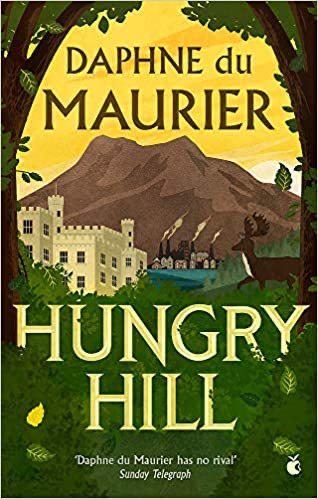
Hungry Hill by Daphne du Maurier
on Amazon*
. . . . . . . . . . .
Wages from wealth
And so the mine on the side of Hungry Hill was started in spite of the opinions of the neighborhood. A Cornishman named Nicholson was secured as captain of the mine and with him he brought some of his own people to work as miners.
That furnished reason for trouble since the Donovans and their friends were bitter against strangers collecting wages from wealth, which, according to their views, belonged solely to them.
The Broderick mine gave up its rich copper and money poured into the family till, but some dark shadow hung over Hungry Hill, a dark shadow under cover of which, something always went wrong.
“Copper John” — as he came to be called — his daughters, Barbara, Eliza, and Jane, and his sons, Henry and John, were caught in an odd chain of circumstances which seemed to be the results of the Donovans’ hatred in league with the mountain’s own resentment against intrusion.
Tragic events occur, the mine cost the life of Jane, and Clonmere Castle was a smoldering ruins while Hungry Hill watched silently.
More about Hungry Hill by Daphne du Maurier
Review on dumaurier.org
Reader discussion on Goodreads
Daphne du Maurier’s Link to Hungry Hill
. . . . . . . . . . .
*This is an Amazon Affiliate link. If the product is purchased by linking through, Literary Ladies Guide receives a modest commission, which helps maintain our site and helps it to continue growing!
The post Hungry Hill by Daphne du Maurier (1943) appeared first on Literary Ladies Guide.
November 17, 2020
10 Poems by Gertrudis Gómez de Avellaneda on Faith, Feeling, and Romance
Gertrudis Gómez de Avellaneda y Arteaga (March 23, 1814 – February 1, 1873), a Cuban-born Spanish writer, was considered one of the greatest romantic poets of the nineteenth century. Presented here are ten poems by Gertrudis Gómez de Avellaneda, both in their original Spanish (poemas) and in English translation, exploring her views on religion and romance.
Much of the themes in Avellaneda’s work focuses on her experiences living in a male-dominated society. She also wrote about themes of love, feminism, an evolving world, and her experience being exiled from Cuba.
Avellaneda’s love for literature started as a child. Growing up, her family’s slaves would do all of her household chores. This left her with a good deal of free time which she used to explore literature and read excessively. She also had brilliant tutors, one being Cuban Poet José María Heredia.
Her literary career began after she published her first poems in Cuba which had a profound influence on Cuban literature. Throughout the remainder of her life, she continued to write despite it being taboo at the time for women to write publicly. Today, her notable works have earned her the reputation of being the “epitome of the Romantic poet.”
. . . . . . . . . .
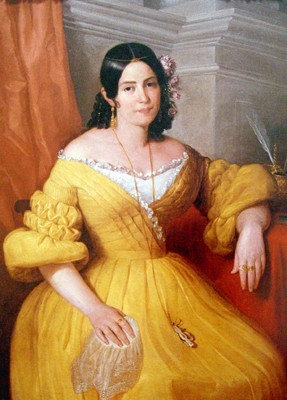
. . . . . . . . . .
Al Partir (On Parting)
¡Perla del mar! ¡Estrella de Occidente!
¡Hermosa Cuba! tu brillante cielo,
la noche cubre con su opaco velo
como cubre el dolor mi triste frente.
Voy a partir… La chusma diligente
para arrancarme del nativo suelo
las velas iza y pronta a su desvelo
la brisa acude de tu zona ardiente.
¡Adiós, patria feliz!, ¡Edén querido!
Doquier que el hado en su furor me impela
tu dulce nombre halagará mi oído.
Ah, que ya cruje la turgente vela,
el ancla se alza, el buque estremecido
las olas corta y silencioso vuela.
On Parting
Sea Pearl! Star of the West!
Beautiful Cuba! your bright sky
the night covers with its opaque veil
How my sad forehead covers the pain.
I’m going to leave … The diligent mob
to tear me from the native soil
the sails iza and ready to wake up
The breeze comes from your burning zone.
Goodbye, happy country! Dear Eden!
Wherever the fairy in his rage impels me
Your sweet name will flatter my ear.
Ah, the turbulent candle cracks,
The anchor rises, the shuddering ship
The short and silent waves fly.
. . . . . . . . . .
A Una Mariposa (To A Butterfly)
Hija del aire, nívea mariposa,
que de luz y perfume te embriagas
y del jardín al amaranto vagas,
como del lirio a la encendida rosa;
Tú que te meces cándida y dichosa
sobre mil flores que volando halagas,
y una caricia por tributo pagas
desde la más humilde a la orgullosa:
Sigue, sigue feliz tu raudo vuelo.
Placer fugaz, no eterno solicita
que la dicha sin fin sólo es el cielo:
Fijar tu giro vagaroso evita,
que la más bella flor que adorna el suelo
brilla un momento y dóblase marchita.
To A Butterfly
Daughter to the wind, snow-white butterfly,
Inebriate with perfume and sunlight,
Wandering from garden to amaranth,
And from iris to fiery rose alighting.
Blessed butterfly, you innocently sway
Over a thousand flowers charmed by your flight,
Each and every flower caressing in turn,
From the humblest to the proudest in the bower.
Continue happily on your swift rounds,
Fleeting, not eternal pleasure seeking,
For endless joy is only in Heaven’s gift;
Avoid a fixed course; wander, wander at will
For the most beautiful flower adorning earth
Shines for a moment, withers, bends and dies.
. . . . . . . . . .
Feliz Quien Junto A Tí… (Happy Who Next to You…)
¡Feliz quien junto a ti por ti suspira,
Quien oye el eco de tu voz sonora,
Quien el halago de tu risa adora,
Y el blando aroma de tu aliento aspira!
Ventura tanta, que envidioso admira
El querubín que en el empíreo mora,
El alma turba, al corazón devora,
Y el torpe acento, al expresarla, espira.
Ante mis ojos desaparece el mundo,
Y por mis venas circular ligero
El fuego siento del amor profundo.
Trémula, en vano resistirte quiero…
De ardiente llanto mi mejilla inundo…
¡Delirio, gozo, te bendigo y muero!
Happy Who Next to You…
Happy who next to you for you sighs,
Who hears the echo of your sonorous voice,
Who praise your laughter worships,
And the soft aroma of your breath aspires!
Adventure so much, that envious admires
The cherub that dwells in the empyrean,
The troubled soul devours the heart,
And the clumsy accent, when expressed, expires.
Before my eyes the world disappears,
And through my light circular veins
The fire I feel of deep love.
Tremulous, in vain to resist you I want …
Of burning tears my cheek flooded …
Delirium, joy, I bless you and I die!
. . . . . . . . . .
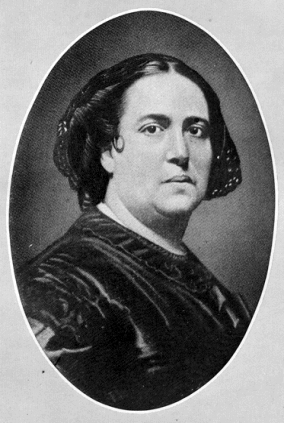 Literary Ladies Guide.
Literary Ladies Guide.
November 13, 2020
The Excellent Marriage of Gertrude Stein and Alice B. Toklas
Gertrude Stein and Alice B. Toklas, both Americans, met in 1907 as new expats in Paris. The two immediately bonded and remained lifelong partners until Stein’s death, with Alice serving as the doting wife, and later, keeper of the legacy.
“I may say that only three times in my life have I met a genius and each time a bell within me rang and I was not mistaken…The three geniuses of whom I wish to speak are Gertrude Stein, Pablo Picasso, and Alfred Whitehead.”
This is the meeting of Gertrude Stein (1874 – 1946) and Alice B. Toklas (1877 – 1967) as written in The Autobiography of Alice B. Toklas (1933). It is Gertrude’s writing, Alice’s voice, and their meeting — twenty-five years previously — recounted as both of them wished to remember it.
Whether true or not, the gravitas of the moment seems fitting. It was, after all, the start of one of the longest and most stable marriages in the history of Modernist literature: a partnership that was often framed in terms of the writer and her muse, and yet was a true partnership built on interdependence and lasting love. For almost forty years, they were never apart.
The dynamics of their relationship, played out in Gertrude’s writing and in the literary and artistic milieu of inter-war Paris, fascinated their contemporaries. They still fascinate and inspire today.
. . . . . . . . . .
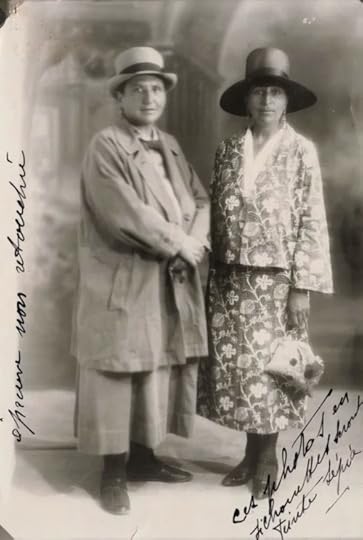
. . . . . . . . . . .
Gertrude Stein and Alice B. Toklas: An auspicious beginning
Gertrude Stein and Alice B. Toklas met in Paris in September 1907, when Gertrude was 34 and Alice 30. Gertrude was already a fixture of Left Bank Parisian life: terrifying some, exasperating others, inspiring many. She had become well known not only for her impenetrable writing, but for championing lesser-known artists and collecting their works.
Together with her brother Leo, with whom she had shared a pavilion and adjoining atelier at 27 rue de Fleurus, she had amassed a collection of works by the likes of Cézanne, Matisse, and Picasso. As a consequence, the atelier had become ‘the’ place for artists to gather to meet each other, to talk, and to admire the paintings. Most of these visits were condensed into a Saturday evening — the famous Stein salon — but visitors were expected and (mostly) welcomed at all hours of the day.
Alice, however, had only just arrived in Paris. She had been persuaded into the trip by a friend, who thought she could do with a change from home life in San Francisco: Alice had been caring for her father and younger brother following her mother’s death.
She was a talented pianist who had been set on a promising concert career and, although she had abandoned her formal studies, her interest in the arts — in music, painting, theatre, and literature — remained unabated. She had also already met Gertrude’s brother and sister-in-law, Michael and Sarah Stein, who had visited San Francisco the previous year.
Just a few days after Alice’s arrival — perhaps out of curiosity, perhaps out of duty towards her brother’s friend — Gertrude called and invited her for a walk. Whatever her motives, the outing was a success. Alice later described the meeting in her own memoirs: “I was impressed with her presence and her wonderful eyes and beautiful voice — an incredibly beautiful voice … Her voice had the beauty of a singer’s voice when she spoke.”
With her short-cropped, iron-grey hair, sandals, and bulky frame clad in long robes, Gertrude was certainly an impressive figure. The contrast they must have presented walking the streets of Paris — for Alice was tiny, dark, mustached, and dressed in flower print dresses and elaborate earrings — must have been striking.
. . . . . . . . .
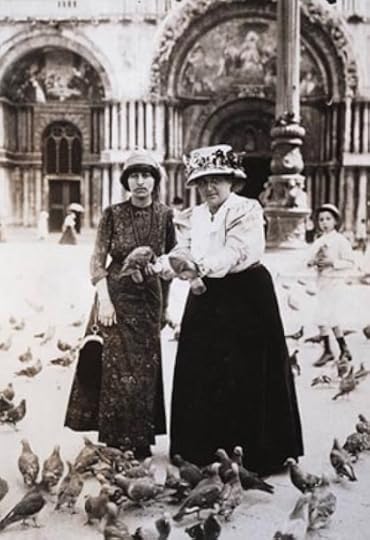
. . . . . . . . .
Rhythm and routine
The two women formed an intense attachment from the beginning. There were further walks around Paris: Gertrude enjoyed wandering the streets and both women loved to shop for clothes. Alice, in particular, was attracted to the new Paris fashions.
As they walked, they talked about Gertrude’s writing. She had just finished her novel Three Lives and was working on The Making of Americans, but was facing an increasing lack of support from her brother. Leo was her closest sibling, the one who had always been there for her and she for him, and yet they were drifting further and further apart. Gertrude needed encouragement and approval, which Alice was happy to provide.
By December 1908, Alice had assumed the roles of editor, typist, secretary, general sounding board, and personal assistant. Each morning she would go to the rue de Fleurus to type Gertrude’s growing manuscript — no easy feat given the illegibility of Gertrude’s handwriting, which even Gertrude herself often struggled to read.
Gertrude would get up around lunchtime, having been writing for most of the night, and she would take coffee with Alice while Alice ate lunch. Sometimes in the afternoons, Alice would return to her own apartment, nearby on the rue Notre Dame des Champs, but more often the two women would take a walk before returning to the rue de Fleurus.
They were not yet lovers, and each evening Alice would leave. Gertrude would then work through the night, a habit she had developed as visitors to see the artworks had become more common. It was, she claimed, only after 11 p.m. that she could be sure the doorbell would not ring.
. . . . . . . . .
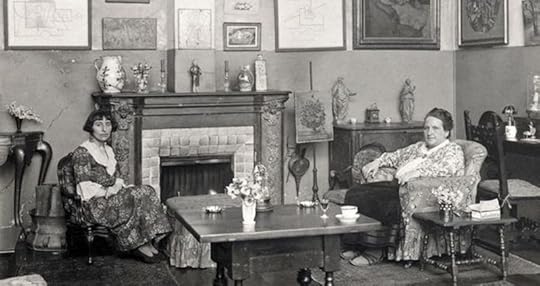
. . . . . . . . . . .
Gertrice / Altrude
By the summer of 1910, Gertrude had “proposed” to Alice, and Alice had accepted. Alice moved into the rue de Fleurus in July and, shortly afterward, Leo Stein moved out. The difference in living arrangements led to a marked change in the style of Gertrude’s writing.
Alice’s roles as a sounding board and as capable editor (she was, by all accounts, more than willing to ask pointed questions and to engage in discussion over the finer points of structure and poetic nuance) gave Gertrude’s writing a second voice: this became more evident as time went on and Gertrude took Alice into her confidence more and more. In one of Gertrude’s notebooks, she even intermingles their names, coming up with ‘Gertrice / Altrude’.
Always, within all of her roles, Alice’s main focus was Gertrude, to attend to her needs and to make sure that she was heard. Gertrude acknowledged this devotion in her writing: in one of her first word portraits, Ada, she wrote, “Someone who was living was almost always listening. Someone who was loving was almost always listening…”
Their relationship also encouraged an exploration of sexuality. Their marriage was Gertrude’s primary inspiration, but she often described it in heterosexual terms with herself as “husband” and Alice as “wife.” Erotic and domestic lesbian themes were couched in cryptic language, perhaps to explore the limits of both the language itself and conventional gender roles, and perhaps to avoid the attention of the censor.
. . . . . . . . . .
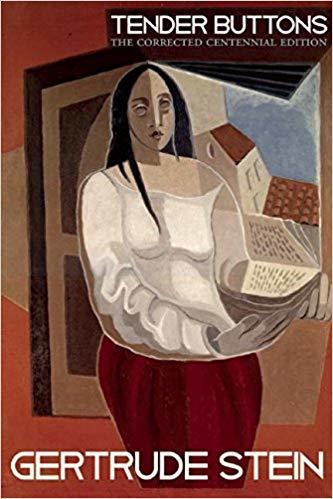
Tender Buttons
. . . . . . . . . .
Tender Buttons
Tender Buttons, written in 1912, is perhaps the piece that most clearly shows the transition Gertrude was making in her work. The sexuality was clear even to those who didn’t know about her relationship with Alice: it was, according to Shari Benstock, a “grammar of lesbian domesticity.”
Later, in Didn’t Nelly and Lilly Love You (1922), Gertrude’s writing undertook a playful exploration of gender that was far more fluid than the roles she and Alice played out in their relationship. This story, of Gertrude and Alice’s birthplaces and their meeting in Paris, begins with the conventional “he” and “she” before morphing into the less clear-cut “we” and “I.”
The ambiguity was frustrating for many; having worked her way through Didn’t Nelly and Lilly Love You, Natalie Barney said tartly that she could never “make out whether they did or they didn’t — the chances being two against one they didn’t.”
A new kind of Stein salon
Both women were aware that, in America, they would not have been able to live out their relationship in nearly so much freedom as in Paris. Neither would Gertrude — cryptic language or not — have been able to explore it in her writing. However, they were still cautious about their choice of friends, and in the early years of their relationship privacy was important.
The famous Stein open house continued in a scaled-down form for several years, but by 1913 it was unrecognizable. Alice did not enjoy that form of entertaining and was never comfortable at large dinners and parties. She preferred smaller, more intimate gatherings, and gradually their social life adjusted.
Those who came to 27 rue de Fleurus on a Saturday now came by invitation only, singly or in pairs. They talked at length with Gertrude while Alice served cakes and tea, or elaborate dinners that she had prepared herself. If male visitors brought their wives, Alice took great pains to keep the women away from Gertrude, occupying them with talk of cooking and needlepoint while their husbands had the privilege of an audience with the writer herself.
Later, Janet Flanner — a regular attendee during the 1930s with her partner Solita Solano, said it was as if “Gertrude was giving the address and Alice was supplying the corrective footnotes.”
No one was allowed to intrude on Gertrude’s work, or to question the relationship of the two women too closely. Alice acted as a kind of indispensable gatekeeper, ensuring that Gertrude received the stimulus of company and conversation when she wanted it, and was left alone when she needed to be to write. It was a role that suited both of them.
. . . . . . . . . .
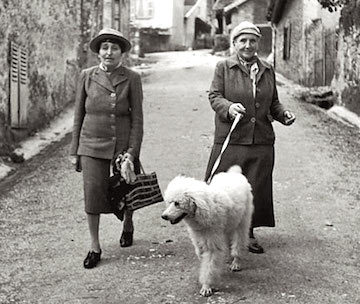
Alice and Gertrude with their beloved dog, Basket
. . . . . . . . .
“Auntie”
This rhythm, like everything, changed with the outbreak of war in 1914. Initially, Gertrude and Alice traveled to Mallorca to sit things out in relative safety. But when it became clear that things were not going to be over quickly, they returned to Paris and volunteered for war work with the American Fund for French Wounded.
They even acquired a car for the purpose, a battered old Ford from Gertrude’s cousin in America which, when repaired and declared roadworthy, was christened “Auntie” after Gertrude’s aunt Pauline who “always behaved admirably in emergencies and behaved fairly well most times if she was properly flattered.”
Always together, and always in Auntie, they spent the next years shuttling supplies and soldiers to and from lines and billets. Gertrude’s driving left something to be desired, however. They had their only real arguments over her inability to reverse.
. . . . . . . . .
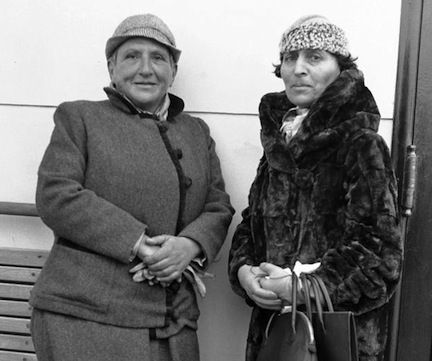
. . . . . . . . .
Postwar Paris and artistic struggles
After the war, as American and British expatriates began to arrive in Paris in greater numbers, Gertrude found herself becoming something of a cult figure. Her work had been published in various of the little magazines, and her reputation was already legendary among the young writers and artists.
She and Alice began to be less restrictive in their social life: they frequented Shakespeare & Co., the new Anglo-American bookshop run by Sylvia Beach, and sometimes attended Natalie Barney’s Friday salons. New friends and old congregated in the winding Left Bank streets: Mabel Dodge, Mina Loy, Janet Flanner and Solita Solano, H.D. and Bryher, Margaret Anderson and Jane Heap.
Despite this, they took care to avoid close friendships with women of the Paris lesbian communities. Neither had ever been particularly demonstrative in public, and both were keen to avoid the kind of gossip and scandal that followed Natalie Barney (whose antics often shocked Gertrude, despite their friendship and general support of each other’s work).
Instead, Gertrude created her own circle of followers through her salon, mostly young and ambitious men such as Ernest Hemingway and Thornton Wilder. She felt she had no need for any other women, even in friendship. Alice provided her with everything she needed, and their life together was, by 1920s standards, relatively quiet: a marriage based on fidelity, their beloved poodle Basket, and regular trips to their home in the country (by this time, “Auntie” had been replaced with “Godiva,” although Gertrude’s driving never improved).
Gertrude continued to write but had little luck with book-length publications. Correspondence with various publishers and editors reveals the extent to which they were confused by her work: one example was Frank Palmer, of Frank Palmer publisher in London, who wrote in 1913 to say that he had “to confess to being as stupid and as ignorant as all the other readers to whom the book has been submitted.”
While Gertrude remained outwardly undaunted, privately she was despairing. Although the rejections may have actually contributed to her reputation during the rebellious 1920s — when, Bryher claimed, any writer who sold a manuscript to an established publisher had to move across the river to the Right Bank for their own safety — she understandably wanted recognition and understanding of her work.
One of her biggest champions, William Carlos Williams, even wrote a “Manifesto” in defense of Gertrude’s writing. But it was Alice who, out of belief in Gertrude and probably more than a touch of frustration, established the Plain Edition Press in 1930 in order to privately publish Gertrude’s work. The venture was financed by the sale of a Picasso.
. . . . . . . . .
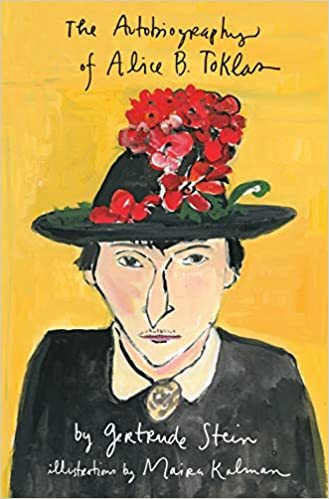
The Autobiography of Alice B. Toklas
. . . . . . . . . .
The Autobiography of Alice B. Toklas
In 1933, the publication by The Bodley Head of The Autobiography of Alice B. Toklas marked a turning point in Gertrude’s life and career. She finally received her first book contract, and its success was such that a Pulitzer was predicted (although it never materialized).
The book was seen as a radical departure from the convention of biography, even though it was possibly the least radical of all of Gertrude’s recent writings, and its success also made Alice a household name. It is, perhaps, ironic that it was not Gertrude’s personal style which eventually brought her the recognition she so craved, but a work written in the ordinary, direct speaking voice of Alice Toklas.
In 1934 both Gertrude and Alice returned to America — the only time they did so — in order to promote The Autobiography. The press loved Gertrude and the book, although there was much debate about both Alice herself (the New York Post reported that, “…she brought with her Alice B. Toklas, her queer, birdlike shadow … her girl Friday talked about Miss Stein, when she talked at all …”) and Gertrude’s style of writing.
Most of the papers could not resist a parody of it, and the Detroit News announced that “A New York literary analyst professes to understand the poems of Gertrude Stein. It complicates the matter considerably, as we must now try to understand the analyst”
The Autobiography also had its detractors, mainly those who were portrayed in its pages and felt their depiction was unfair. A supplementary issue of transition magazine was published entitled ‘Testimony against Gertrude Stein’ to allow those people to have their say.
The World War II years
When war broke out again in 1939, there was no question of volunteering. Aged 66 and 63, and both of Jewish heritage, Gertrude and Alice retreated to their country home in the South, leaving the art collection stored under lock and key in their Parisian apartment.
In a later article for Atlantic Monthly magazine in 1940, Gertrude explained their decision to stay in France by saying that leaving would have been “awfully uncomfortable and I am fussy about my food.”
They managed to survive the hardships and rationing of the war years, supported by the villagers who kept their presence as Jews a secret. Some sources suggest that they were also helped by Gertrude’s friendship with Vichy government officer Bernard Faÿ.
It was certainly Faÿ’s influence that helped to save the art collection from Nazi looting while Paris was under occupation, and it was at Faÿ’s suggestion that Gertrude translated a selection of speeches by Marshal Philippe Pétain. Although destined for an American audience, these translations were never published.
The support for Pétain that Gertrude displayed in her introduction was unpalatable to American publishers, and in 1941 she stopped translating. Her main work from these years was Wars I Have Seen, a documentation of her observations and experiences throughout two world wars. It received mixed reviews, with many feeling that Gertrude’s political observations overreached her grasp and others denouncing her continued support for Pétain. In autumn 1944, they moved back to Paris.
. . . . . . . . . .
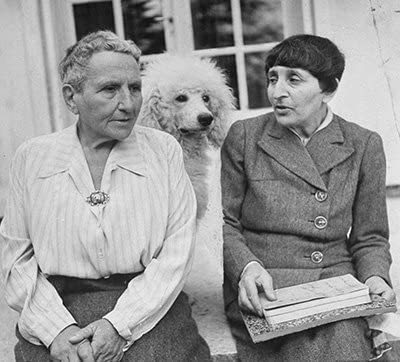
. . . . . . . . . .
Carrying on alone
Gertrude died of cancer on 27 July 1946. Alice was left to carry on alone, and the journey wasn’t an easy one. While their marriage had never been recognized in the eyes of either the law or society in general, Janet Flanner commented that Alice, in her grief, “was the most widowed woman I ever saw.”
Over the years, Alice’s practical situation became more and more precarious. In increasingly poor health and almost blind, she returned to Paris from Rome one summer in 1961 to find the walls of her apartment stripped bare: Gertrude’s collection of paintings had been impounded.
The artwork was supposed to have been insurance for Alice in her old age, with Gertrude’s will stipulating that certain of the works could be sold in order to pay for Alice’s upkeep as well as for the publication of Gertrude’s work.
However, members of the Stein family had taken an inventory of the collection while Alice was away, discovered that several Picasso drawings were missing (having been legitimately sold for the purposes of maintenance), and requisitioned the lot, claiming that Alice’s absence had invalidated the will and endangered the paintings.
The long absence from Paris had also left her facing eviction: her landlord sued, claiming that the property had effectively been left vacant. With the help of friends (including Janet Flanner, who highlighted Alice’s plight in one of her “Letters from Paris” for The New Yorker) Alice was able to find a new home. She was philosophical about the loss of the paintings, saying only that, “I am not unhappy about it. I can remember them better than I can see them now.”
Living alone, she was cared for by devoted friends who believed that she deserved all the little extravagances they could afford her (such as strawberries from Fauchon’s — Janet even kept an empty Fauchon box handy so that it could be refilled, when money was tight, with cheaper neighborhood fruits instead).
In 1965, increasingly frail, she underwent cataract surgery. The bills were largely paid for by Gertrude’s old friend Thornton Wilder, and Virgil Thomson also helped out, joking that Alice was determined to have the surgery so that she “could see Gertrude clearly when the time came.”
She also wrote several books of her own, including The Alice B. Toklas Cookbook in 1954, which combined recollections of her years with Gertrude with recipes and anecdotes about French cuisine (and famously included a recipe for hashish fudge), and her memoirs What Is Remembered.
Touchingly, her recollections end with Gertrude’s death, and with Gertrude’s famous last words: “What is the answer? I was silent, In that case, she said, what is the question?”
. . . . . . . . . . .
Contributed by Elodie Barnes. Elodie is an author, poet, and artist with a serious case of wanderlust. She is originally from the UK, but has spent time abroad in Europe, the United States and the Bahamas.
When not traveling or working on her current projects — a chapbook of poetry, “The Cabinet of Lost Things,” and a novel based on the life of modernist writer and illustrator Djuna Barnes — she can be found with her nose in a book, daydreaming her way back to 1920s Paris. Visit her on the web at Elodie Rose Barnes.
Further reading
The Autobiography of Alice B. Toklas, Gertrude Stein: Penguin Classics, 2001
Women of the Left Bank, Shari Benstock: Virago, 1987
Paris Was A Woman: Portraits from the Left Bank, Andrea Weiss: Counterpoint 1995
Two Lives: Gertrude and Alice, Janet Malcolm: Yale University Press, 2007
Charmed Circle: Gertrude Stein & Company, James Mellow: Praeger Publishers, 1974
Everybody Who Was Anybody: A Biography of Gertrude Stein, Janet Hobhouse: G. P. Putnam’s Sons, 1975
Gertrude Stein in Words and Pictures: A Photobiography, Renate Stendhal (ed): Algonquin Books, 1989
The post The Excellent Marriage of Gertrude Stein and Alice B. Toklas appeared first on Literary Ladies Guide.
November 9, 2020
Gertrudis Gómez de Avellaneda
Gertrudis Gómez de Avellaneda y Arteaga (March 23, 1814 – February 1, 1873), a Cuban-born Spanish writer, was considered one of the most romantic writers and greatest women poets of the 19th century.
Avellaneda was born in Santa Maria de Puerto Principe, currently known as Camagüey. Upon arriving in Cuba in 1905, her father, Manuel Gómez de Avellaneda y Gil de Taboada was a Spanish naval officer in charge of the port of Nuevitas.
Her mother, Francisca María del Rosario de Arteaga y Betancourt, was a criolla and a member of the wealthy Arteaga y Betancourt family, one of the most high-ranking families in Puerto Principe. Gertrudis was the first-born of the couple’s five children, but only she and her younger brother, Manuel, survived past childhood.
Family and childhood
Avellaneda, or “Tula,” as she was nicknamed, grew up spoiled, as the family’s slaves did all the household chores. This left her with a lot of free time, which she used to read excessively. She had impressive tutors as well, one being Cuban poet José María Heredia.
Her father passed away in 1823 when she was nine years old. Ten months later, her mother married Gaspar Isidoro de Escalada y López de la Peña, a Spanish lieutenant colonel stationed in Puerto Principe. Avellaneda was not fond of her stepfather as she felt he was too strict. Thankfully, she would only see him perhaps three months out of a year, as he was often stationed away from home.
At the age of thirteen, her grandfather arranged for her to marry a distant relative who was among one of the wealthiest men in Puerto Principe. In exchange for marrying him, her grandfather promised to give her a fifth of his estate. Two years later, at the age of fifteen, Avellaneda canceled the engagement, resulting in being cut out of her grandfather’s will. This upsetting experience fostered her deep resentment towards arranged marriages and patriarchal authority.
. . . . . . . . . .
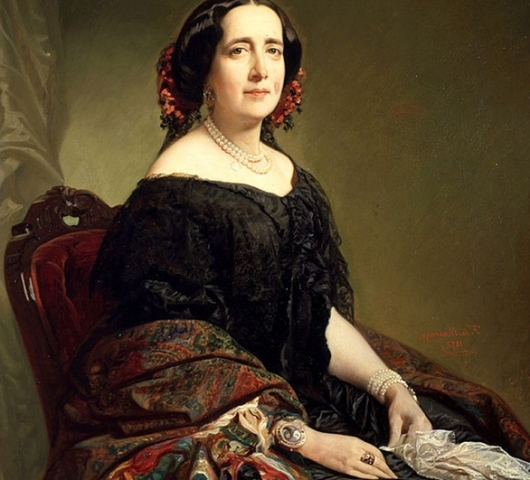
. . . . . . . . . .
Leaving for Spain
In 1836, there was fear of a potential slave rebellion in Cuba. As a result, Escalada had his wife sell her property and slaves, leave Cuba, and go to Spain. Avellaneda was in favor of this plan, as she wanted to meet her father’s family in Andalusia, a southern community in Peninsular Spain.
By April 9, 1836, the family started their journey to Europe via Bordeaux, France, arriving in the city of A Coruña in Galicia, Spain, where they stayed for two years.
In Galicia, she met her fiancé, Francisco Ricafort, the son of Mariano Ricafort, a Capital-General of Galicia. Yet the couple never did marry, because Avellaneda wanted to wait until she was economically independent. This would prove daunting, as her stepfather withheld her inheritance.
Leaving for Madrid
Francisco was sent over to fight in the Carlist Wars, so Avellaneda decided to leave Galicia and go to Seville with her brother Manuel. This was the last time she would ever see Francisco, though Avellaneda was delighted to finally leave Galicia. She was often criticized by Galician women for refusing to do manual labor and for her passion to study.
After arriving in Seville, Avellaneda fell in love with Ignacio de Cepeda y Alcalde, a wealthy and educated young man. He became the focus of her writings, as she considered him her first real love. Between 1839 and 1854, there were a total of forty love letters which his widow later inherited and published after his death.
In July 1839, she wrote an autobiography, which biographers have perhaps over-relied on for information about her early life. Avellaneda wrote it intending to make a good impression on Cepeda. It was the second of four autobiographies she wrote in her lifetime.
Despite their immense love, the two did not get married. Cepeda felt that she was not rich enough and did not like her outspoken ways, a trait seen as too aggressive for women of her time. When their relationship ended, she left for Madrid.
Heartbreak at the peak of her career
Madrid was home to many of Avellaneda’s love affairs, some including prominent writers connected to Spanish Romanticism. In the course of her busy love life, she was engaged on and off several times.
One affair was with Seville poet Gabriel Garcia Tassara. They had a daughter out of wedlock in 1844. Tassara refused to acknowledge the baby as his, and she died at nine months, leaving Avellaneda heartbroken.
After Tassara broke her heart, she met and married don Pedro Sabater, a wealthy writer and poet, on May 10, 1846. Shortly after their marriage, Sabater fell ill with what was believed to be cancer of the larynx and died, leaving Avellaneda devastated. After his death, she wrote Egilona, a play that didn’t receive positive reviews.
In January 1853, Avellaneda attempted to enroll in the Royal Academy. A seat opened up after the death of her friend, Juan Nicasio. Even though many of its members respected her work, it was taboo for women to write publicly. Although the all-male academy members were impressed by her writing ability and works, in the end they refused to allow a woman into the Royal Academy.
. . . . . . . . . .
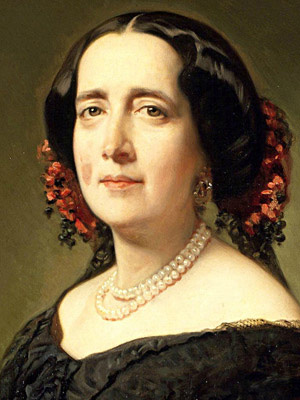
. . . . . . . . . .
Returning to Madrid
On April 26, 1855, she remarried colonel don Domingo Verdugo y Massieu. As a result of her husband’s injuries, the couple had to move from Madrid back to Cuba, their birthplace, in 1859. They had a close relationship with Francisco Serrano who, at the time, was the captain-general of Cuba.
Upon arriving in Cuba, concerts, music, and parties welcomed her. Verdugo’s health deteriorated soon after their arrival to Cuba and on October 28, 1863, he passed away. This left Avellaneda distraught, so she set off to visit New York, London, Paris, and Seville, and ultimately returned to Madrid.
Themes in Avellaneda’s work
Avellaneda’s writings were most popular in the 1840s and 1850s. Themes in her stories included love, feminism, and an evolving world. Her writing style was influenced by French, English, Spanish, and Latin American poets, especially Hispanic poetry deriving from late neoclassicism and romanticism.
Her writings often reflected on her experiences and were infused with the bold attitude she had to adopt to navigate a male-dominated society. She also wrote of her exile from Cuba, and her bouts with depression. There are many other themes present in her works, including love, eroticism, neoclassical concepts, religion, philosophical meditations, and historical references.
One of Avellaneda’s most famous and controversial novels was Sab, published in 1841. This novel spoke out against slavery and was banned in Cuba due to its unconventional approach to problems in society. The novel, along with many others, was considered scandalous because of themes of interracial love and divisions within society.
. . . . . . . . . .
Gertrudis Gómez de Avellaneda page on Amazon*
. . . . . . . . . .
Awards and honors
In 1845, Avellaneda was awarded two prizes in a poetic contest organized by the Liceo Artístico y Literario de Madrid.
On August 20, 1895, The New York Times stated that “Gertrudis Gómez de Avellaneda, the great Cuban poetess, is declared by all critics to have no equal in modern times.”
On June 4, 1896, the newspaper reports on a ceremony held in honor of Avellaneda given by Fidel Pierra:
“Fidel Pierra, the chairman of the fair committee, described the life of the foremost Cuban poetess. No one in the whole Spanish, Parnassus said, was to be compared with Gertrude Gomez d’Avellaneda, who was born in Cuba in 1814, and did most of the beautiful work of her life there. Mr. Pierra’s appreciative tribute was the first which has been paid in the congress to the genius of a Cuban woman.” (Multiple News Items 12)
Avellaneda was one of the few nineteenth-century poets to be granted two laureates as a tribute to her talent. The first laurel crown was awarded to her in Madrid by Liceo artistico y literario in 1844 and the second was awarded in Havana by Cuban Liceo IN 1860.
On August 25, 1900, The New York Times published an article under the title “Cuban literature” that suggested that Avellaneda was a female literary genius by emphasizing her precocity as a writer.
Final years and legacy of Gertrudis Gómez de Avellaneda
In her final years, Avellaneda lived in Madrid. Soon after her brother Manuel’s death in 1868, she published her first volume of collected literary works. She decided to omit Sab and Dos Mujeres because of the extreme controversy of these two works. On February 1, 1873, the prolific writer passed away in Madrid at the age of 58. She was buried in Seville next to her dear brother Manuel.
In 2009, Cuban authorities requested that her remains be transferred to Cuba, but Seville and the Canary Islands firmly rejected doing so. Today, Avellaneda is widely viewed as the “epitome of the Romantic poet, the tragic heroine who rises to public acclaim yet, in private, is bitterly unhappy.”
. . . . . . . . . .

. . . . . . . . . .
More on Gertrudis Gómez de Avellaneda
Major works
Sab (1841)
Cecilia Valdés (1839)
Espatolino (1856)
Baltasar: A Biblical Drama in Four Acts and in Verse (1858)
Biographies
Gertrudis Gómez de Avellaneda by Hugh A. Harter (1981)
Fashioning Feminism in Cuba and Beyond: The Prose of Gertrudis Gómez de Avellaneda by Brigida M. Pastor (2003)
More information and sources
Wikipedia
Encyclopedia
Britannica
Salient Women
The Biography
Skyler Isabella Gomez is a 2019 SUNY New Paltz graduate with a degree in Public Relations and a minor in Black Studies. Her passions include connecting more with her Latin roots by researching and writing about legendary Latina authors.
. . . . . . . . .
*This is an Amazon Affiliate link. If the product is purchased by linking through, Literary Ladies Guide receives a modest commission, which helps maintain our site and helps it to continue growing!
The post Gertrudis Gómez de Avellaneda appeared first on Literary Ladies Guide.
November 4, 2020
Eileen Chang
Eileen Chang, also known as Chang Ai-ling or Zhang Ailing (September 30, 1920 – September 8, 1995), was a Chinese essayist, novelist, and screenwriter. Although Chang’s somber love stories are widely recognized, her construction of an alternative wartime narrative is considered one of her most significant contributions.
Chang was born in Zhang Ying in Shanghai, China to a well-known family; her grandfather was a son-in-law to Qing court official Li Hongzhang. In 1922 when Chang was two, her family relocated to Tianjin. Soon after, her father introduced her to Tang poetry at the age of three. Her mother also introduced her to painting, piano, and English in her early years.
Early life
While in Tianjin in 1924, Chang’s father became addicted to opium and frequented prostitutes. As a result, her mother decided to leave to study in France with her aunt. During this time, Chang started school at the age of four where she excelled in English.
After three years in France, Chang’s mother returned to Tianjin in 1927 after her father promised to end his drug usage and affairs. They moved back to Shanghai in 1928 for a fresh start, but to no avail, the marriage ended in 1930. After their divorce, Chang and her younger brother, Zhang Zijing, were raised by their father.
. . . . . . . . . .
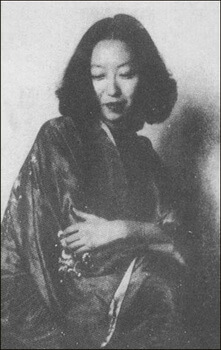
. . . . . . . . . .
Education
At the age of ten, Eileen Chang’s mother renamed her Ailing in preparation for becoming a student at an English school. In 1937, Chang graduated from St. Mary’s Hall in Shanghai, an all-female Christian high school. Throughout her time in school, it was evident that she had a talent for literature, and had writings published in her school magazine. She read Dream of the Red Chamber, one of the Four Great Classical Novels of Chinese literature, which later influenced her works throughout her career.
Upon graduating, she contracted dysentery, an infection of the intestines. Rather than help her seek treatment, her father physically abused her and confined her to her bedroom for six months. Shortly after her eighteenth birthday, she ran away to live with her mother.
In 1939, Cheng was accepted to the University of London with a full scholarship. But with war rumbling in Europe, she was unable to attend and instead studied English Literature at the University of Hong Kong. There she met Fatima Mohideen, who would become a life-long friend. Chang was one semester short of earning her degree in December 1941, but when Hong Kong fell to the Empire of Japan, she was unable to finish.
. . . . . . . . . .
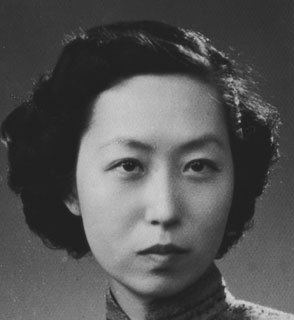
. . . . . . . . . .
Starting a writing career
In 1943, Cheng was introduced to Zhou Shoujuan, a prominent editor. Then tweny-three years old, she showed him some of her written work and soon after, with Zhou’s commendation, she became the most promising new writer in Shanghai.
Over the next two years, she wrote some of her most notable works, including Love in a Fallen City and The Golden Cangue (1943). She also wrote novellas and short stories that were collected in Romances (1944). It became an immediate bestseller in Shanghai and from there, gained traction with Chinese readers throughout the country. Chang became a literary star.
Final years in China
In 1945, a collection of Cheng’s essays appeared as Written on Water. Her reputation began to diminish due to postwar cultural and political disorder. This worsened after the Communist takeover in 1949. In 1952, Chang left China for Hong Kong after realizing her writing career in Shanghai was over.
Chang worked as a translator in Hong Kong for the United States Information Service for three years. During this time, she wrote The Rice Sprout Song, her first novel entirely in English. While in Hong Kong, she also translated numerous English books into Chinese, including books by Ernest Hemingway. In 1955, Chang left for the United States, never to return to China or Hong Kong again.
. . . . . . . . . .
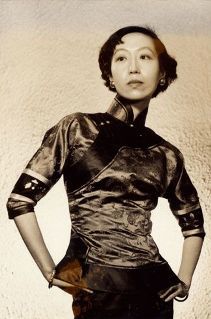
. . . . . . . . . .
Marriages
In the early 1940s, Chang met her first husband, Hu Lancheng, who was 37 at the time. The two married in a private ceremony, Fatima Mohideen being the only one in attendance.
Some labeled Hu as a traitor because he was collaborating with the Japanese during World War II, but Chang remained loyal. Their marriage ended when Hu seduced a seventeen-year-old nurse while staying at a local hospital. Soon after Japan was defeated in 1945, he changed his identity, moved to the nearby city of Wenzhou, and married Fan Xiumei. Hu and Chang officially divorced in 1947.
After her divorce, Chang attended the MacDowell Colony in New Hampshire. There she met and developed a relationship with American screenwriter Ferdinand Reyher of Philadelphia. The couple married in New York City on August 14, 1956, and moved back to New Hampshire. Chang became a U.S. citizen in 1960 and went to Taiwan to seek more opportunities, returning after two years. Reher suffered several strokes in the course of the marriage and became paralyzed. He passed away on October 8, 1967.
. . . . . . . . . .
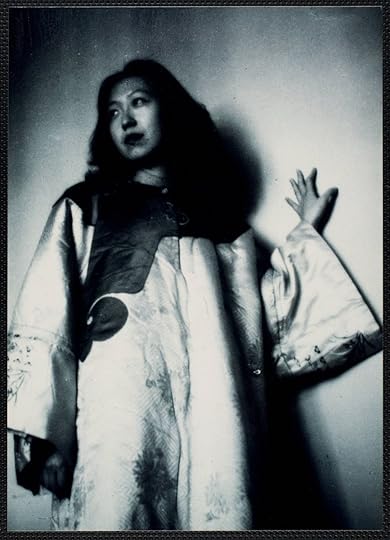
. . . . . . . . . .
Themes in Chang’s work
Chang’s work focuses a great deal on the issues among men and women in love. Some critics consider her work to be among the best Chinese literature of the period. Her focus on everyday life in 1940s Shanghai and Hong Kong was noted for its absence of political subtext, something many writers of her time could not achieve. She also depicted powerlessness and the somber truth of human life in a smooth and graceful style.
Awards and honors
Chang has been listed as one of China’s four women geniuses, along with Lu Bicheng, Xiao Hong, and Shi Pingmei. Many films, television dramas, and theatrical plays were created based upon her works.
Director Ang Lee won his second Golden Lion Award at the Venice Film Festival for his film, Lust, Caution, a film based upon Chang’s short story.
. . . . . . . . . .
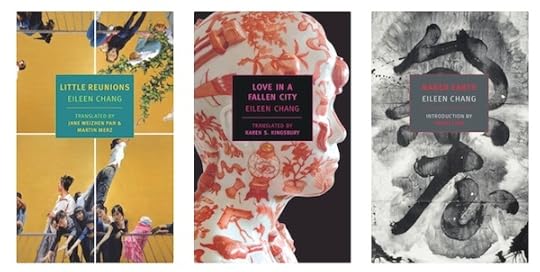
Eileen Chang page on Amazon*
. . . . . . . . . .
Later years
In 1969, Chang became a senior researcher at the Center for Chinese Studies of Berkeley where she conducted research on special terms used by the Chinese Communists. She relocated to Los Angeles in 1972. In 1978, Crown Magazine published “Lust, Caution,” “Fu Hua Lang Rui,” and “Xiang Jian Huan.”
Chang passed away on September 8, 1995, in her apartment on Rochester Avenue in Westwood, Los Angeles. Her landlord became concerned after she had not answered her telephone for several days and discovered her lifeless body soon after. According to her death certificate, she died from cardiovascular disease. As per Chang’s will, she was cremated with no memorial service. Her ashes were scattered in the Pacific Ocean
Legacy of Eileen Chang
Many Taiwanese creative writers of the 1970s were influenced by Chang. In the 1980s and 1990s, young women authors came together as a group inspired by her and her works. Many notable authors were inspired by Chang, including Wang Anyi, Su Tong, and Ye Zhaoyan.
Poet and Southern California professor Dominic Cheung said, “had it not been for the political division between the Nationalist and Communist Chinese, she would have almost certainly won a Nobel Prize.”
. . . . . . . . . .
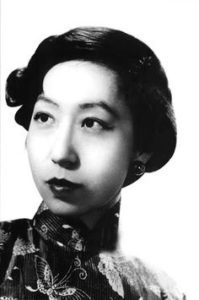
More about Eileen Chang
Works in English translation
Half a Lifelong Romance (1948)
Little Reunions (2018)
Love in a Fallen City (1943)
The Golden Cangue (1919-1949)
Lust, Caution (2007)
Naked Earth (1956)
The Rice Sprout Song: a Novel of Modern China
The Rouge of the North
Traces of Love and Other Stories
The Sing-song Girls of Shanghai
Written on Water
Sealed Off
Jasmine Tea
Films adapted from Eileen Chang’s novels:
Qing Cheng Zhi Lian (1984)
Yuan Nu (1988)
Hong Meigui Yu Bai Meigui (1994)
Ban Sheng Yuan (1997)
Lust, Caution (2007)
More information and sources
Wikipedia
Britannica
New World Encyclopedia
Reader discussion of Chang’s books on Goodreads
Skyler Isabella Gomez is a 2019 SUNY New Paltz graduate with a degree in Public Relations and a minor in Black Studies. Her passions include connecting more with her Latin roots by researching and writing about legendary Latina authors.
. . . . . . . . .
See more of Literary Ladies Guide’s author biographies.
*This is an Amazon Affiliate link. If the product is purchased by linking through, Literary Ladies Guide receives a modest commission, which helps maintain our site and helps it to continue growing!
The post Eileen Chang appeared first on Literary Ladies Guide.

